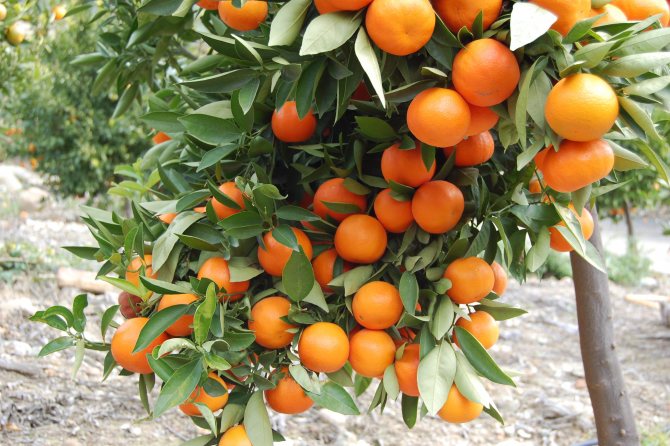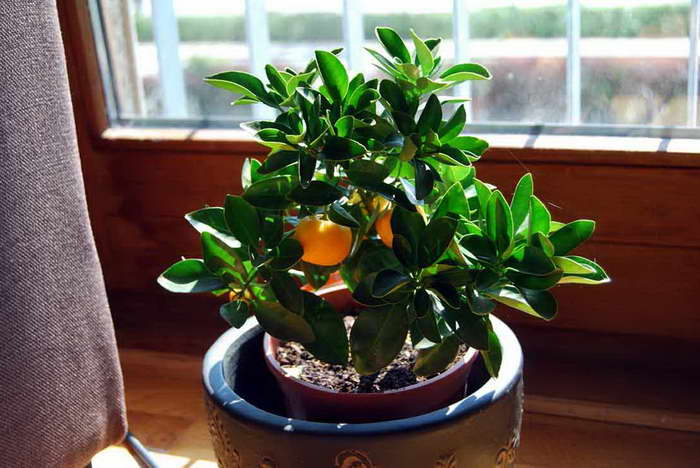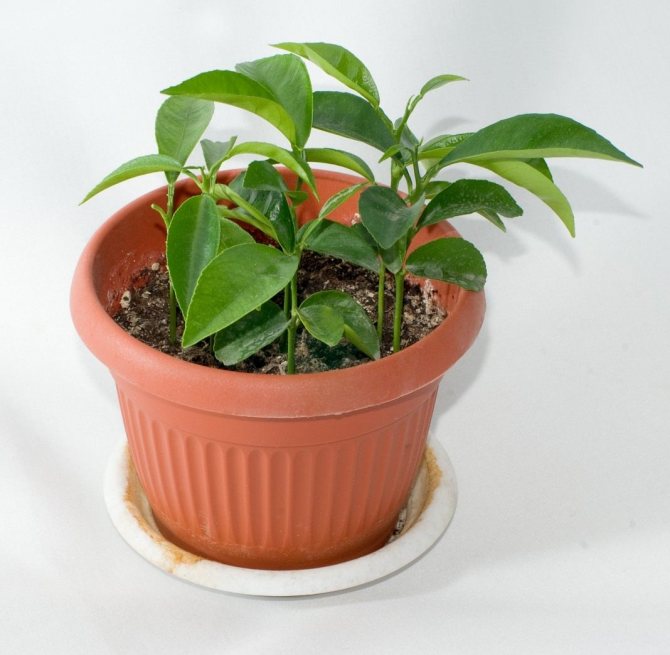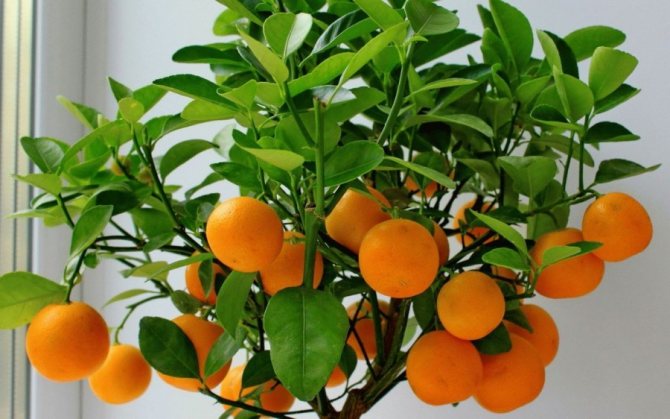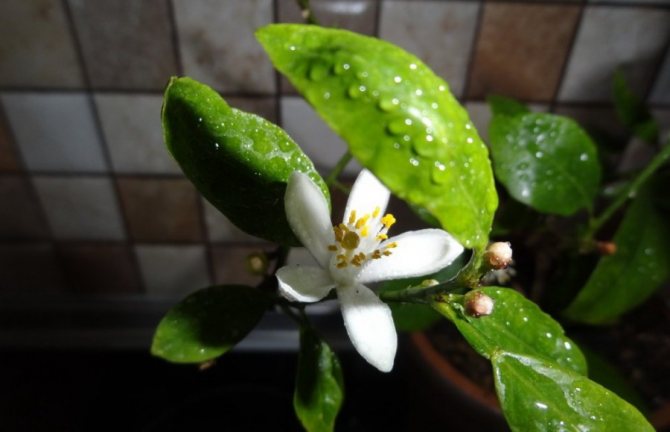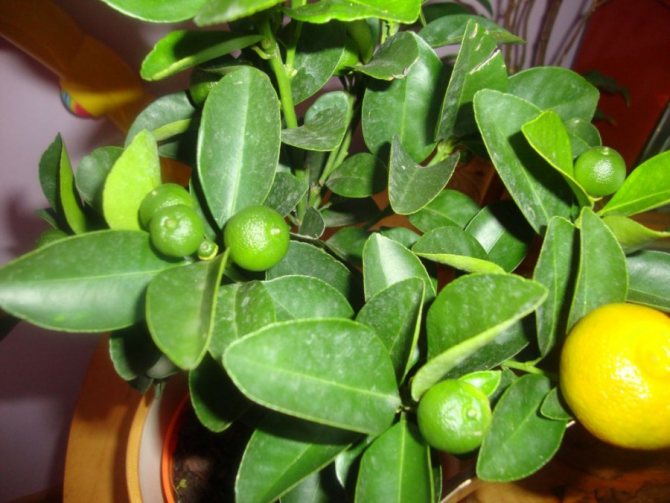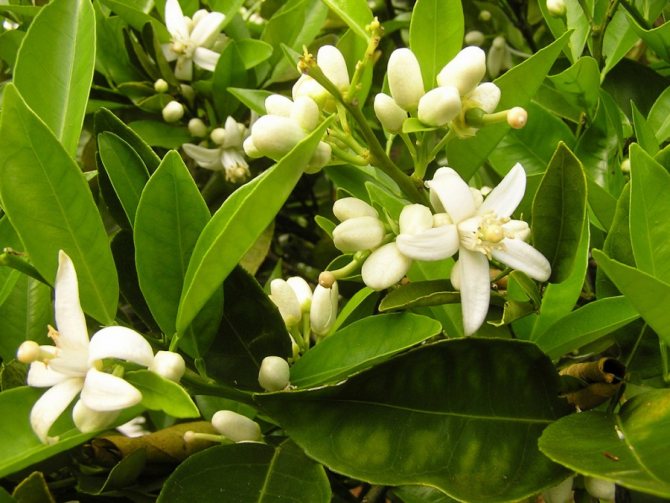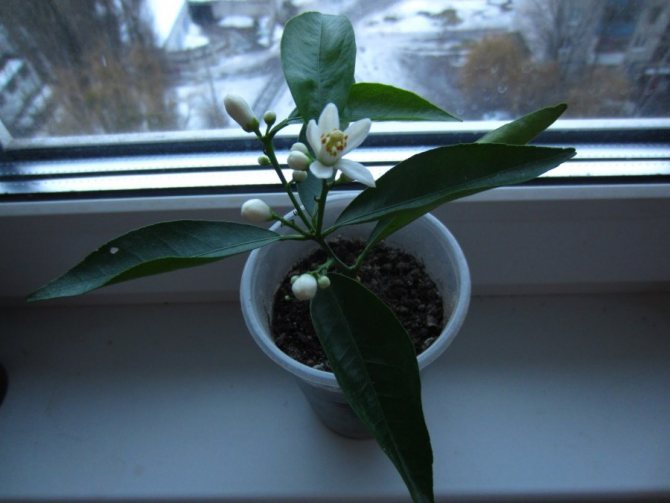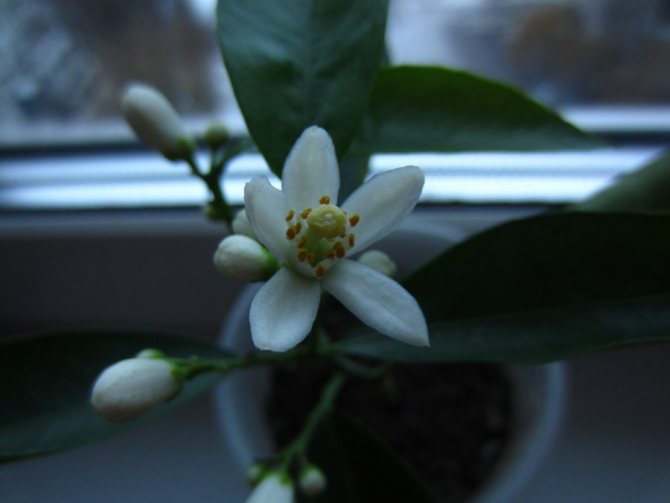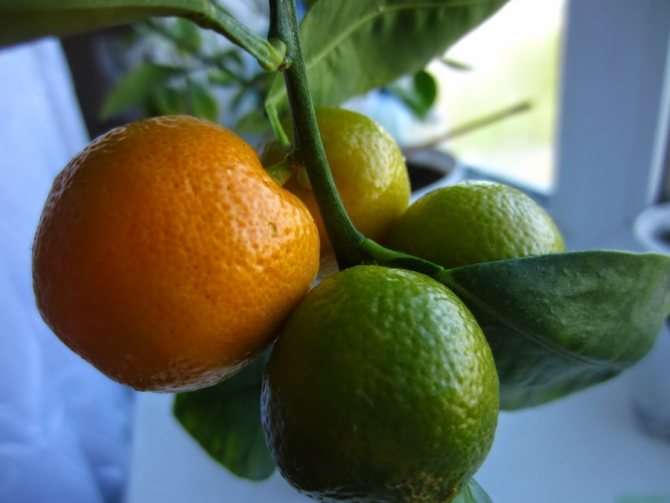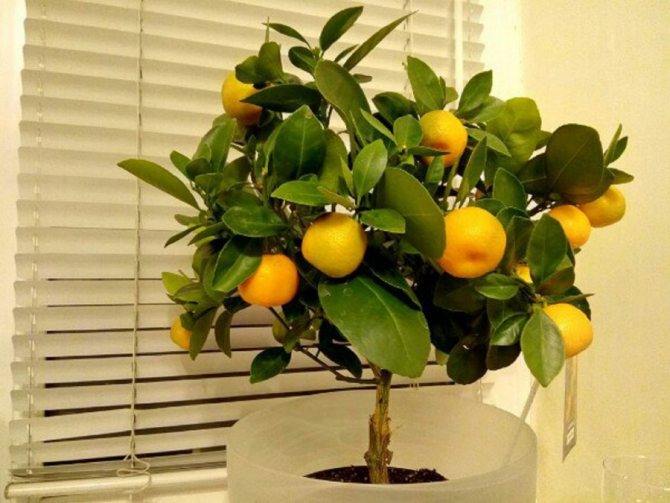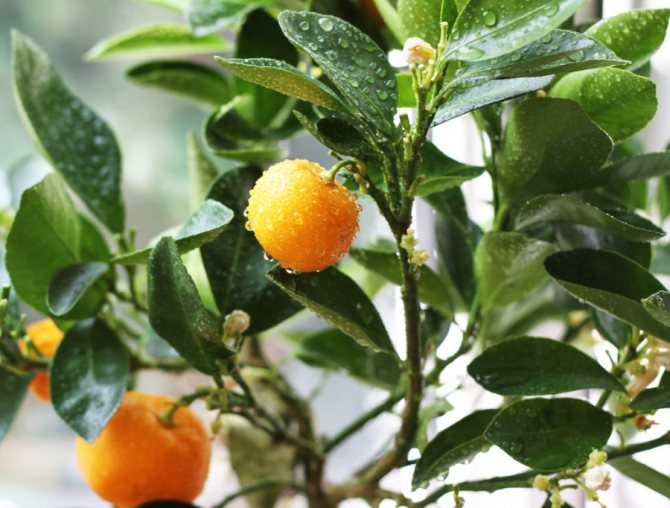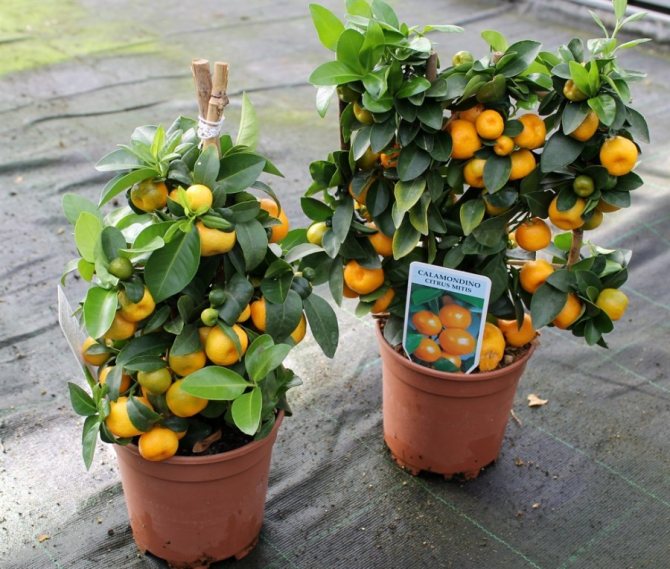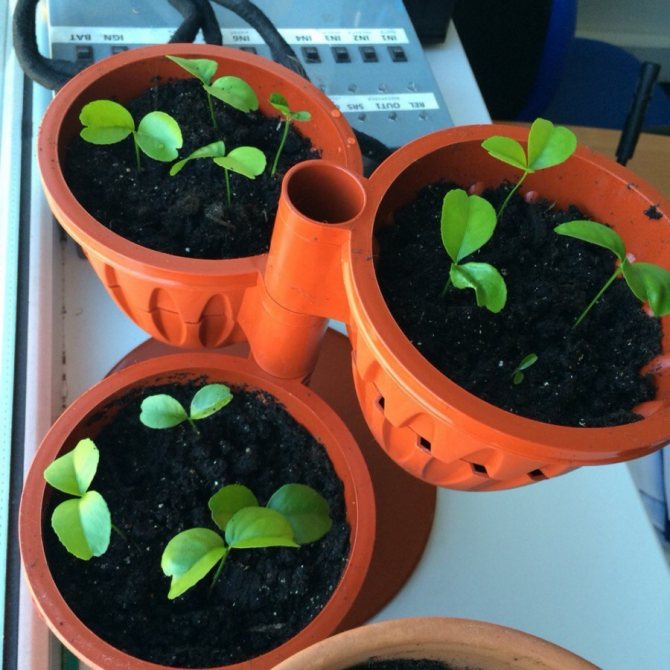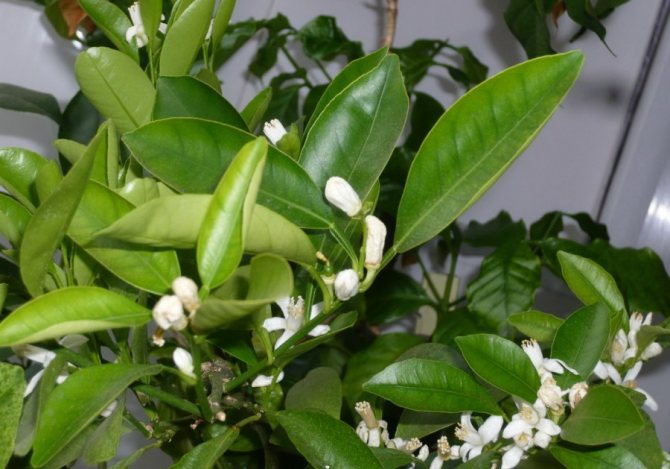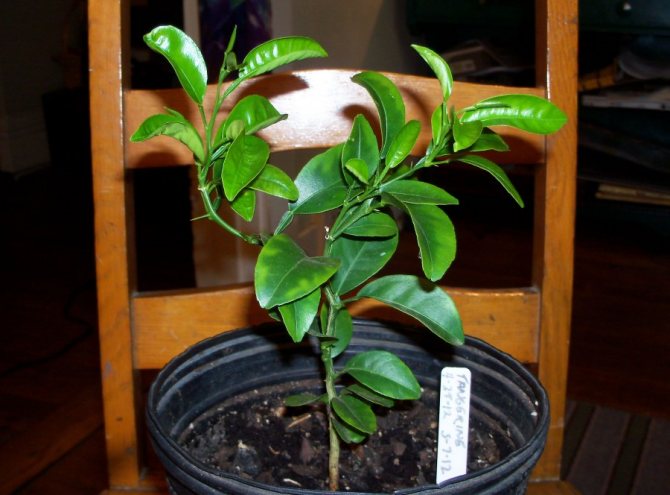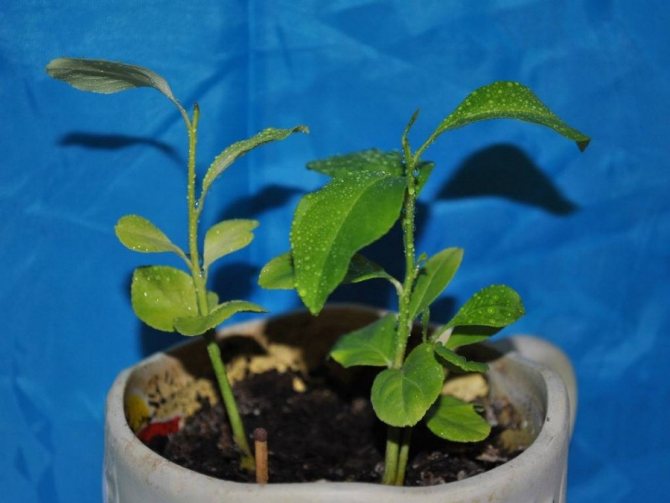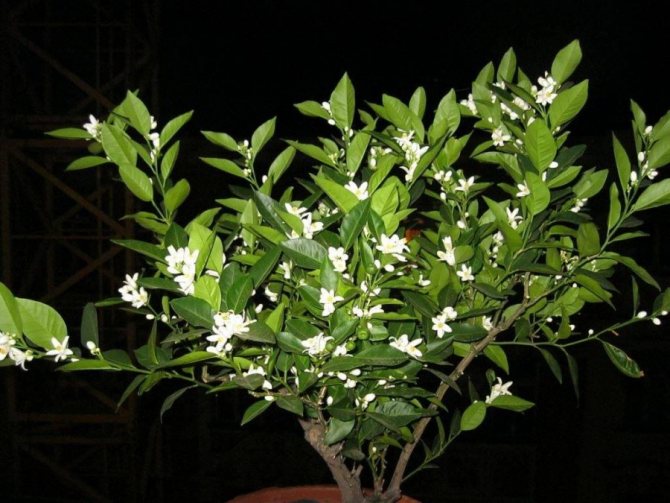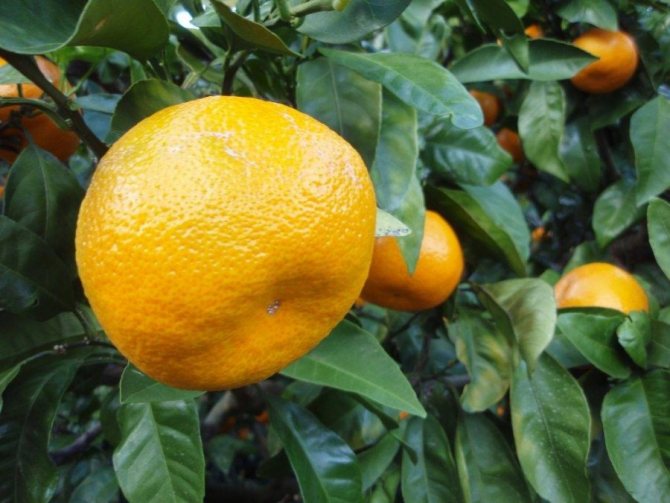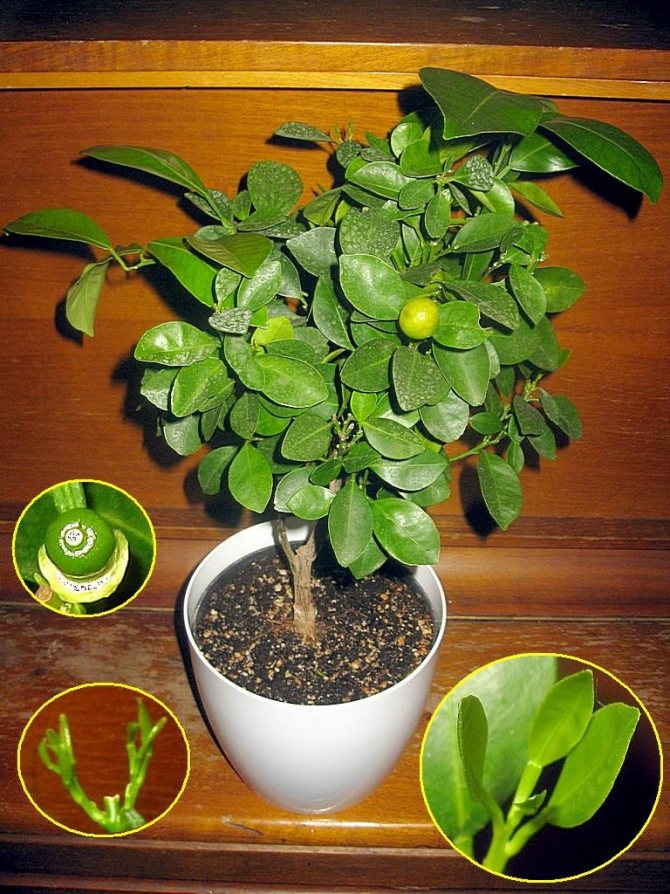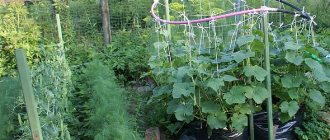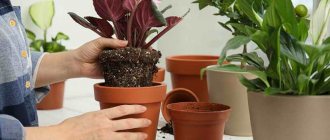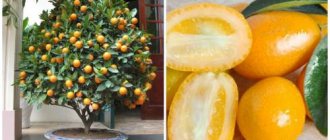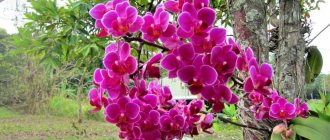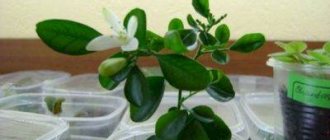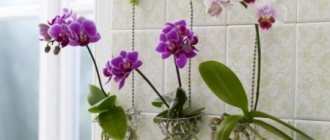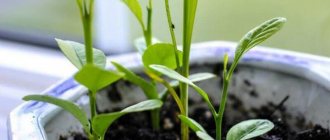For many people, the word "tangerine" is probably associated with the anticipation and feeling of celebration. However, this is not only one of the most festive fruits. Of all tropical fruits, mandarin is second only to lemon in popularity, and the limited area of natural cultivation (Transcaucasia, the Black Sea coast, Abkhazia and the Sochi region are considered the most northern regions for the spread of this culture) makes it one of the most desirable citrus fruits in any home. With all this, mandarin is used in cooking, in the food industry, and in medicine.
It is not surprising that with such a demand, many people tend to grow it at home. And I must say that they have all the possibilities for this: there are special varieties of mandarin that lend themselves to cultivation in conservatories, greenhouses, greenhouses or in an ordinary room. Depending on the growing conditions, they can reach a height of one and a half or two to three meters. Such a tangerine is called "decorative" or home, indoor.
Preparation process
By buying a tangerine or growing it from a bone in an apartment, you will make sure that this culture is not too spoiled. If a person decides to grow a citrus tree at home, he should understand the intricacies of caring for the plant.
How to understand that it's time to transplant a tangerine tree:
- the plant is transplanted annually in the first 6 years;
- citrus at the age of 7 years should be moved to another pot every 2 years;
- manipulations are carried out in early spring: tangerine trees are transplanted in March, at this time the tree has not fully awakened after winter, the juice slowly moves along its branches and roots;
- a plant that has begun to bloom is not transplanted, otherwise the citrus will weaken and shed its buds;
- an adult mandarin should not be disturbed at the beginning of autumn, especially when fruits appear on it: in autumn, only young trees, whose age is less than 3 years, can be transplanted.
In order not to create unnecessary stress on the tree, the grower must make sure that it is time to "relocate" the tangerine. After watering, you should make a small tunnel and feel the condition of the roots. After making sure that the root system of the plant is tightly wrapped around the soil, get ready to transplant the citrus.
If the roots are loose, and you see that they are not cramped in the soil, it is undesirable to move the tree to another pot. To add nutrients to the southern plant, you can change the topsoil, and keep the pot the same.
Types and varieties of mandarin
Mandarin is characterized by strong polymorphism, as a result of which groups of its varieties (or even individual varieties) are described by different authors as independent species. Fruits of tropical varieties stand out with a particularly great variety.
Typically, mandarin varieties are divided into three groups:
- in the first group - very thermophilic noble tangerines (Citrus nobilis), which have large leaves and relatively large yellowish-orange fruits with a large tuberous skin;
- the second group consists of thermophilic and smaller-leaved tangerines, or Italian tangerines (Citrus reticulata) with rather large orange-red fruits of a slightly elongated shape, covered with a plump skin (its smell in some varieties is sharp and not very pleasant);
- the third group includes satsum (or unshiu) (Citrus unshiu) is native to Japan, characterized by cold resistance, large leaves and small, thin-rimmed yellowish-orange fruits (often green on the skin). It is satsum, which endure short-term slight frosts (up to -7 degrees), that are successfully grown on the Black Sea coast.
Unlike noble mandarins and tangerines, seeds are very rarely found in satsum fruits - therefore, this variety is probably also called seedless mandarin. When grown in containers, its varieties usually grow up to 1-1.5 m. Slender mandarin trees with a beautiful crown of slightly drooping twigs, covered with numerous dark green leaves, especially decorate the house during abundant flowering and fruiting and fill it with wonderful smells.
As a result of crossing mandarin with other citrus fruits, a variety of hybrids are obtained:
- clementines (Clementina) - (mandarin x orange) - with small or medium-sized, flattened, very fragrant orange-red fruits, covered with a shiny thin skin (polyspermous clementines are called montreal);
- elendale (Ellendale) - (mandarin x tangerine x orange) - medium to large orange-red seedless fruits with exquisite taste and aroma;
- tangoras (Tangors) - (orange x tangerine) - have large (10-15 cm in diameter), flattened, red-orange fruits with a relatively thick, large-pored skin;
- minneola (Minneola) - (tangerine x grapefruit) - differ in a variety of sizes of red-orange fruits (from small to very large), in shape - elongated-rounded, with a "tubercle" and "neck" at the top;
- tangelo, or tangelo (Tangelo) - (mandarin x pomelo) - have large red-orange fruits the size of a medium orange;
- santinas (Suntina, or Sun Tina) - (clementine x orlando) - with fruits that outwardly resemble noble tangerines, with an exquisite sweet taste and aroma;
- agli (Ugli, Ugly) - (tangerine x orange x grapefruit) - the largest among hybrids (fruits with a diameter of 16 -18 cm), flattened, with a coarse large-pored yellow-green, orange or yellow-brown peel.
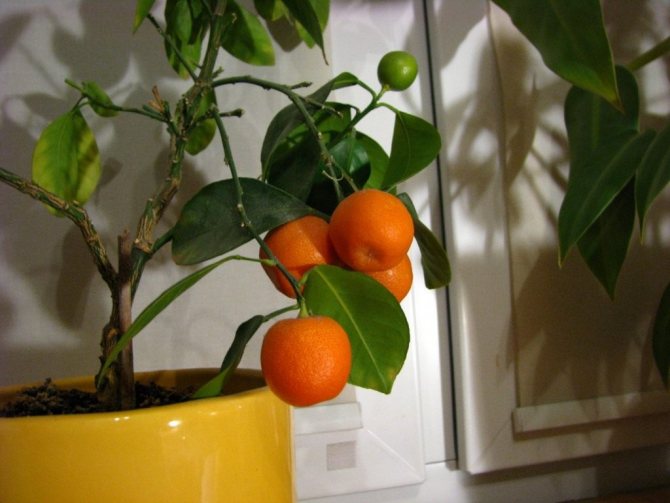
Tangerine tree in a pot. <>
Selecting a new container
When choosing a new tangerine pot, you need to take into account important nuances:
- the root system of citrus trees grows rapidly, so cramped flowerpots are not the best choice for these plants;
- pick up a miniature flowerpot for a plant that was in a plastic cup for the first year of its life;
- pottery or plastic pots are suitable for citrus trees;
- drainage holes must be in the pot;
- tangerine trees grow poorly in long narrow containers, there is a risk of root rot;
- the new flowerpot should be 3 cm larger in diameter than the previous container.
If you are using a container for transplanting a citrus tree in which another flower has recently grown, it is worth sterilizing the pot. After the pot has been thoroughly washed, it is poured over with boiling water. This will help protect the mandarin roots from bacteria.
Discard the idea of planting a tangerine next to a different type of tree. The experience of flower growers has shown that tangerine trees feel uncomfortable next to flowering perennials (geraniums, clivia). In one flowerpot, 2 tangerine seedlings can develop well, and the trees must be of the same age.
How to understand what a young plant is missing
If there is not enough iron, then on the leaves of the mandarin (regardless of the color of the leaf itself), a network of veins will stand out brightly. It will be bright green, especially the central core. If there is a lack of iron, the growth of the plant will be suspended.
The consequences of improper plant maintenance
The lack of manganese is similar. The veins will also be bright green, but the tissue between them will turn yellow, and then completely turn into dead.
Sulfur. Starting from the veins, the entire leaf becomes either pale green or pale yellow in color. It will not turn completely yellow, but some yellowness will appear. The absence of sulfur does not lead to tissue death.
Lack of calcium. The lack of this substance is more dangerous for the plant. In the absence of calcium, the mandarin leaf first becomes discolored, and then the upper edge begins to curl down. Further, the top and edges of the leaf begin to die off, which can lead to foliage falling off.
Boron shortage leads to various modifications of foliage. Particularly noticeable factors are deformation of the leaf plate and various types of discoloration, usually at the top of the leaf.
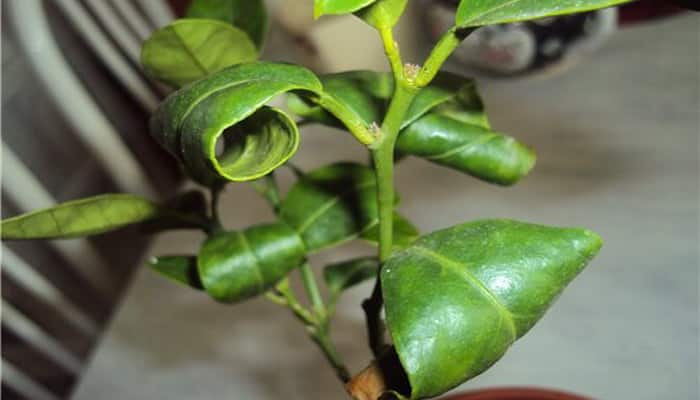

Signs of a copper deficiency in a plant
If the citrus lacks copper, then the plant begins to wilt. The leaf becomes an unnatural dark green color. And the shape of the leaf becomes not symmetrical. The central vein may also change, it becomes arched. And on the fruits, tar-like smudges may appear.
An adult plant may lack completely different elements.
How to grow a gorgeous citrus tree?
Potting requirements
In order for indoor tangerines to thrive, they need a suitable substrate. The plant loves light, slightly acidic soil.
When choosing the soil for your homemade citrus, give up the idea of buying something cheap. High-quality mixtures are more expensive in stores than their "average" counterparts.
After opening the package, carefully examine the potting mix. The grower should alert the smell of mold coming from the soil. The second sign indicating the low quality of the material is the presence of large seeds and plant roots in the ground. Transplanting a tangerine tree into such a dubious substrate is highly undesirable.
If the florist does not trust store mixes, he can independently prepare the soil for planting a plant.
You should take one part of humus (cow dung), one part of coarse river sand and the same amount of leafy soil. The main component of the mixture is sod land. It will need 3 parts. All components are mixed, then a small amount of clay is added to the substrate.
Tangerine from the bone - analyzing the difficulties
Before deciding to grow a tangerine from a bone, you need to think: how much are you willing to work hard to achieve a result, and what exactly do you want from the tree you are growing - just decorative or also fruits? Are you ready to wait? The pitted tangerine grows rather slowly. Do you agree to experiments? In order for the plant to bloom, it will take more than one year, and there are often cases that the tangerine, in general, does not bloom, then you will need to help him.
In addition, if a tangerine grown from a stone produces fruits, they do not look like those from which the seed was taken (in order for the variety to repeat, it must be propagated vegetatively - by cuttings, grafts). However, what turns out, in any case, pleasantly surprises!
Transplant features
Having made a soil mixture, the florist prepares high-quality drainage for planting a plant. What material is suitable for this purpose:
The pot is filled with 3 cm drainage material. Soil is laid on top of it. How is a mandarin transplant carried out:
- the tree is transplanted by the transshipment method; do not greatly destroy the earthen lump taken out of the old pot;
- attention is paid to the root system of the tree: when transplanting a tangerine into a new flowerpot, make sure that its roots do not curl or crumple;
- the plant should not be immersed too deep in the ground, since the tree can rot; after transplanting "activities", make sure that the root collar of your homemade citrus remains at the same level above the soil as in the previous pot;
- the position of the tree in the pot should be vertical;
- moisten the soil after the procedure, the top layer of the soil will immediately be compacted;
- add a little soil mixture to the pot half an hour after watering, water the transplanted tangerine again.
Mandarin formation
Mandarin is one of those plants that often have to be shaped. The first pinching (if he did not start branching himself) is done to him when the seedling reaches a height of 30-40 cm. This technique makes the tree start up side shoots of the first order. But this is not enough for flowering, because tangerine bears fruit only on branches of the 4th-5th order. Therefore, the pinching is continued, removing the tips of all shoots after 4-5 leaves, as well as weak shoots and those that grow inside the crown. In general, it takes 3-4 years to form.
But to force the branching of the first-order branches, you can go the other way - reject the shoots with a commit. This method is more time consuming, but quite interesting. For its implementation, one end of the wire is fixed on a branch, and the other is fixed with a hairpin at the edge of the pot so that the formed mandarin shoot tilts closer to a parallel position with respect to the ground.
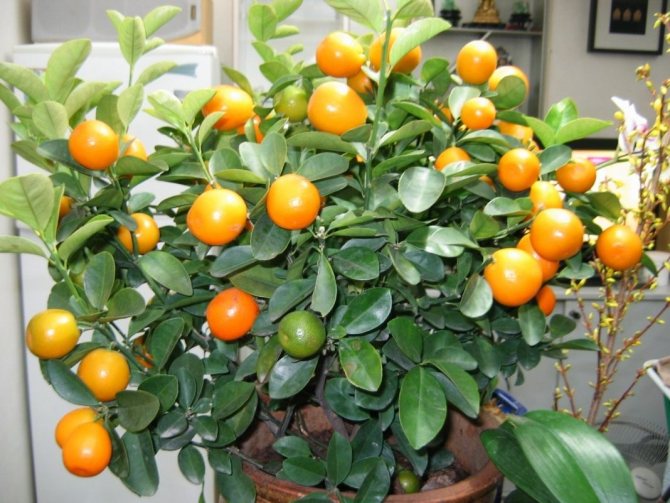

Mandarin tree (Citrus reticulata). <>
Caring for transplanted tangerines
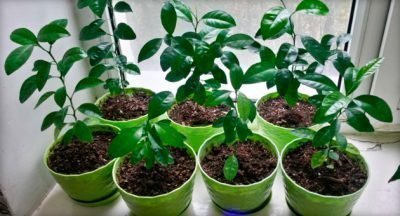

A tangerine placed in a new pot needs careful maintenance. The prerequisites for adapting a citrus crop in a new container are as follows:
- regular moderate watering: tangerine does not tolerate drought, in the summer, the plant should be watered daily;
- normal soil moisture: it is undesirable to overmoisten the soil under a citrus tree, this rule is especially important in the autumn months;
- tangerine trees are watered with settled water: cold liquid is not suitable for watering citrus plants, it must be warmed up to room temperature;
- the first month after transplantation is the most difficult for the plant, at this time, unnecessarily, do not move the flowerpot with the green pet to another place, protect the tangerine from drafts;
- constant spraying of the leaves and stems of the tree is necessary;
- long-term lighting is necessary so that the plants do not get sick: in the winter months, lighting for the southern plant with phytolamps should be organized; the duration of daylight hours for citrus plants should be 8-10 hours;
- in the summer season, citrus seedlings should be protected from the midday sun;
- hardened tangerine trees will take root better: in spring and summer, flowerpots with plants are taken outside for several hours. If you live in an apartment in a multi-storey building, you can take flowerpots with plants to the balcony. When hardening a tree, it is important not to allow the north wind to blow in its direction.
How to propagate a tangerine tree at home?
There are two main ways tangerines can be propagated:
- Seed
... The whole technology of germinating seeds and planting sprouts was discussed above. It is only worth noting that such a plant must be vaccinated for fruiting. Due to certain difficulties and duration of the process, many growers prefer to purchase a ready-made seedling. The tangerine tree from the store is usually already grafted, so it only needs to create favorable conditions for growth. - Vegetative
... A tangerine tree that has been properly cared for at home can be propagated by cuttings. To do this, young shoots with 2-3 leaves are cut off and placed in water for several hours with any root-forming solution. After that, the cutting is planted in nutritious soil and a greenhouse is built. Rooting will occur within 2-3 months.
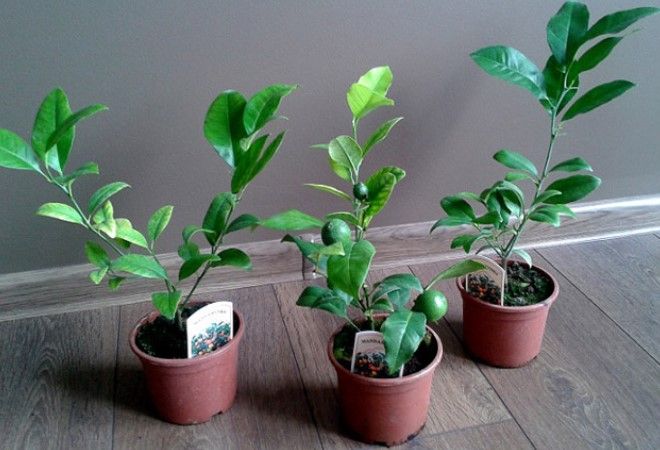

Purchase rules
In nurseries and networks, as a rule, new fruit trees are already being sold. All that remains is to bring them into the home, periodically feed and water them.However, ready-made citrus fruits are quite expensive, therefore it is easier and more profitable to grow a tangerine tree at home from a seed or sprout.
The latter option is easier, but before purchasing a small branch, you need to ask the seller for a certificate. Unfortunately, there are impious traders in the market who, instead of tangerines, sell calamondins. They also bear fruit and have a citrus aroma, however, their fruit has no taste. Cheaters are mainly found in supermarkets and markets, because their reputation is very dear to specialized nurseries.
Ornamental mandarin varieties
Due to the appearance of its fruits, dense dark green leaves and the aroma of flowering, indoor tangerine is recognized as a very effective plant, and if it is also grown in the form of a bonsai, then it can be called a work of art without exaggeration. The most popular are the following varieties and groups:
- Unshiu. It is considered the most unpretentious, early-growing, fast-growing and productive variety of all available. It branches well, has a spreading crown, thornless branches and wide leathery leaves. In indoor conditions, it grows to a maximum of one and a half meters, bears fruit already in the third or fourth year. Flowering time - spring, beginning of fruiting - end of October / November. Fruits are small, yellowish-orange in color, thin-crusty, pear-shaped, without seeds.
- Vasya is a group of low-growing low varieties, in which three varieties are distinguished: Kovano, Miha, Miyagawa. Next to these names, the general name of the whole group is usually indicated with a hyphen, so they look like this: Kovano-Vasya, Mikha-Vasya, Miyagawa-Vasya. They reach a height of 40-80 cm, so it is very convenient to grow them on a regular windowsill. Abundant flowering, fruiting begins in the second year of cultivation, the fruits have a rich orange-yellow color.
- Shiva Mikan. An early compact, fast-growing small-fruited variety weighing no more than 30 grams. and with large fleshy dark green foliage.
- Murcott. A rare compact variety, whose fruits are remarkable for their extraordinary sweetness. Ripening time is summer.
The following varieties of decorative mandarin are also known: Tangier, Robinson, Tardivo di Ciaculli.
There are also hybrids of mandarin and some other citrus fruits. For example, Clementine is a very popular hybrid of mandarin and orange. At home, it begins to bear fruit, depending on the height he has reached. Abundant fruiting: one adult tree can produce up to fifty medium orange-red, slightly flattened fruits with a good aroma and a shiny skin. In addition to this hybrid, elendale, tangoras, minneola, tangelo, santin and agli are also known.
In many varieties, fruiting directly depends on the height of the plant. The dependence is as follows:
- With a growth of 20 cm, the tangerine begins to bear fruit after 60 months.
- At 21 - 30 cm - after four years.
- At 31 - 40 cm - after three years.
- At 41 - 50 cm - in two years.
- At 51 - 75 cm - after a year and a half.
- From 76 cm to 1 meter - in the second year after the start of cultivation.
How to prepare the land
Sour soil containing peat is not suitable for citrus plants. The soil for growing a tangerine tree should be both nutritious and light, retain moisture and allow air to pass through. To prepare the earth, you need to mix several components with each other:
- the same amount of sod and leafy soil;
- coarse disinfected sand;
- humus.
Instead of humus, it is permissible to use compost, since it also contains many nutrients and useful substances. When the plant reaches three to four years, a little oily clay is added to the bud. It will protect the roots from drying out and will maintain a normal moisture level.
In a tub or pot of citrus, you need to pour a 3-5 cm layer of drainage. For this purpose, you can use clay shards, pebbles or expanded clay..
Problems when growing tangerine
Yellowing and falling foliage
This problem can have different causes. It is important not to rush, to carefully analyze the condition of the plant and make the correct diagnosis. In adult tangerines, the leaves may turn yellow and fall off due to their old age. But at the same time, the tree itself looks healthy and develops normally.
General lighting of foliage may indicate insufficient lighting of plants. In this case, you need to take care to rearrange the tangerine closer to the light, or arrange artificial lighting for it.
The shedding of mandarin leaves can begin due to too dry air (in the absence of regular spraying, especially during the heating season), improper transplantation (when the root collar is deepened, choosing too large a pot volume), drafts. If one of these reasons is found, they simply need to be eliminated.
Drying and falling off of the lower leaves of a mandarin, despite the fact that the leaf begins to dry from the tip, is associated with regular waterlogging of the soil. This phenomenon occurs either as a result of over-grooming, or due to too large a pot in relation to the seedling. In any case, the plant must be transplanted into an appropriate pot with fresh, loose (breathable) soil, after removing the rotten roots.
If the yellowing began from the bottom of the crown and spreads to the top, this indicates a lack of nitrogen. In this case, the tangerine must be fed with nitrogen fertilizers.
The light yellow color of young tangerine leaves, which gradually passes over to old leaves, indicates chlorosis (lack of iron). Treatment with iron chelate will help here.
Mandarin leaves fall off without any obvious reason - perhaps the plant lacks potassium. In this case, it must be fed with potassium nitrate.
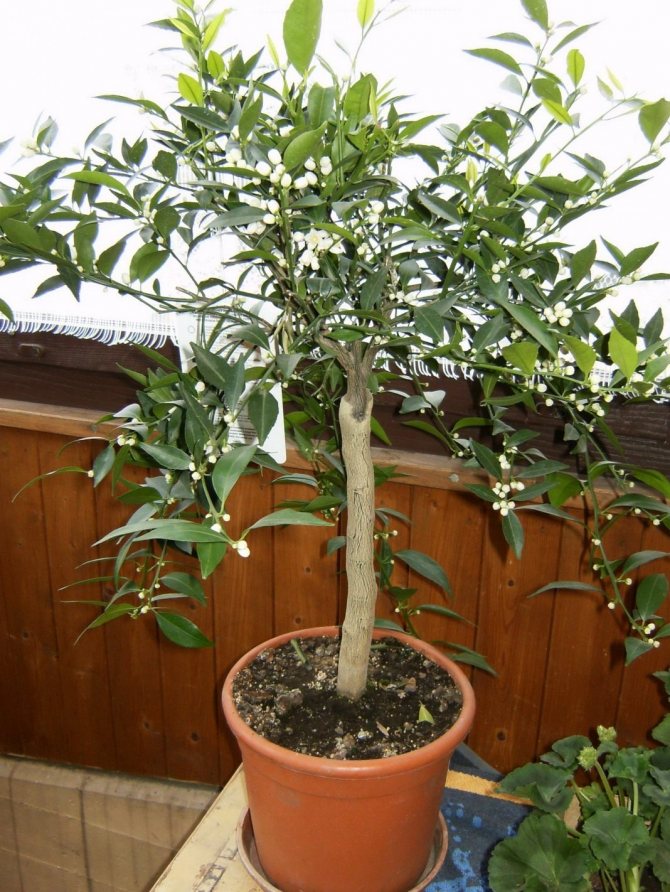

Blooming tangerine tree. <>
How to transplant citrus
Each year, the tangerine tree needs to be transplanted into a larger pot because the growing citrus needs more space. A specialist is advised to immediately place a mandarin for three to four years in a tub, in which he will be for the next several years.
It is recommended to transplant in the spring, when the plant begins to actively develop. To begin with, pull out a small horseshoe to inspect the root system. If the tree is firmly entangled with a soil lump, then it can be replanted. If the adhesion is not very tight, then replace the topsoil and wait for next year. The experts give the following instructions for the correct transplant:
- First of all, the soil at the edges must be thoroughly moistened so that it does not stick to the walls of the pot.
- To simplify the work, you can knock on the vessel with your hand or a small spatula.
- Take the tree directly by the trunk and remove it from the ground along with a clod of earth. It is not necessary to remove the old soil from the plant, otherwise it can be easily damaged.
- Prepare a new container with earth and drainage layers in advance. Place a tree in it, sprinkle with earth.
- When compacting the soil, do not press too hard on the surface. Then the citrus should be thoroughly watered and placed on the window.
When replanting the plant, do not cover the roots completely. The top of the root collar should be exactly on the surface. So a homemade tangerine tree will soon take root.
Transplanting a tangerine tree without risk of injury
Since not everyone knows how to care for a tangerine tree in a pot, pay attention in a timely manner to the need for a transplant. At home, it must be carried out carefully, follow the instructions.
one.Water the soil along the sides of the tub with settled (filtered, rainwater) water so that it has less adhesion to the walls of the pot.
2. Take a spatula or any other object. Tap the pot gently from all sides. The same actions can be carried out with the palm of your hand, lightly tapping on the tub. You will make it easier to separate the roots and soil from the walls of a clay or wooden pot.
3. Take the tree by the trunk closer to the base, carefully remove its root system along with the rest of the earth. There is no need to remove any remaining soil, otherwise you may damage the plant.
4. Take care of a new pot with a drainage system in advance, it is necessary to cover it with a layer of earth. Install the dug tree inside, sprinkle with soil.
5. Only lightly tamp the soil, but do not press too hard. Water the citrus tree, set the pot in a sunny location.
Important!
When transplanting, you do not need to completely sprinkle the root collar of the tree with earth, otherwise it will take root for a long time. The top section of the neck must remain on the surface.
The root collar is understood as the line that separates the roots and the trunk. There is a small seal in this area, it must be partially covered with earth.
Humidity and temperature
In the springtime, buds appear on citrus fruits. During this period, it is important that the temperature indicators in the room are not less than 20 degrees. If the thermometer dropped below this mark, then the citrus begins to become covered with empty flowers.... Of course, they smell very nice, but there will be no harvest..
In winter, the tree is recommended to be placed in a cool room. The temperature should decrease gradually, otherwise the plant may quickly shed its leaves. In the coolness, citrus will begin to gain strength and rest. After such a "hibernation" the plant will produce more fruits.
Mandarins love moisture and warmth, so in hot weather, the plant needs to be sprayed several times a day. In summer, it is recommended to always keep a basin or bucket of water near the pot. This will prevent the ambient air from drying out. In winter, experts advise installing special ionizers and humidifiers. The room where the tree stands must be ventilated from time to time, moving it away from the window.
Recommended varieties of tangerine for growing in the house
- Unshiu - frost-resistant, fast-growing, very productive variety. The tree is undersized, with a spreading crown of thin, very flexible branches covered with corrugated leaves. This mandarin branches beautifully, grows quickly, blooms profusely and willingly. The fruits are pear-shaped, without seeds. Under artificial illumination, it grows incessantly.
- "Kovane-wasse" - a strong tree with thick branches; branches reluctantly. This mandarin variety can grow quite large for the size of the apartment. The leaves are fleshy, hard. It blooms profusely. Fruits are medium in size, orange-yellow.
- "Shiva-Mikan" - a compact, fast-growing tree with large, fleshy, dark green foliage. Early, it blooms well. Average yield; fruit weighing up to 30 g.
- "Murcott" (Honey) is a very rare variety with a compact bush. The pulp of this tangerine, ripening in summer, is sweet as honey.
Mandarin orange
Watering nuances
When the soil becomes very dry, the plant can get sick with spider mites. The soil in the tub should be slightly damp, so in summer citrus should be watered every day, and in winter it should be limited to two or three waterings per week.
The soil must be tested with a finger. If it is too dry and crumbly, then add water. In this case, it is necessary to monitor the absence of liquid in the pan, otherwise the tangerine tree may rot.
For irrigation, you need to use rain or melt purified water. Infuse the liquid for three to four days in a large vessel, then process with a filter. It is forbidden to water the plant with tap water, as heavy salts and suspensions can harm it.
The amount of water for irrigation depends on the ambient temperature and the size of the citrus fruit. If a liter of water is enough for a small plant, then an adult will need at least three to four liters. In this case, the water must be heated to forty degrees. To check the temperature of the liquid, you can simply lower your finger into it.
It is advisable to water at the root, avoiding water drops on the trunk and leaves. It is better to spray the crown from a spray bottle so that the water is distributed as evenly as possible. When tangerines are in bloom, care must be taken that the liquid does not come into contact with the buds. It is better to water the tree in the morning. Water will awaken the plant and activate metabolic processes.
What is the disease of decorative mandarin
Like many other plants, especially those growing in not very favorable climates, ornamental mandarin is susceptible to certain diseases. Most often it is struck by:
- Shield.
- Red spider mite.
- Mealybug.
- Leaf spot followed by their fall.
If the defeat of the mandarin by pests is protracted and persistent, then potent chemicals are used to cure it, however, their use within the apartment can lead to unpleasant consequences, so it is better not to bring the situation to such a measure. If the initial stage of the disease is fixed, you can do with improvised means. For example, the shield can be removed by spraying with soapy water, diluted in 3 liters. water 2 tbsp. l. liquid soap or "Fairy", before cleaning off the insects. The solution should be on the plant for about half an hour, after which it is washed off with warm water. A water-oil emulsion is also very effective: 1 tsp. machine oil is stirred in a glass of warm water, 40 gr is added to it. households soap and 2 tbsp. l. washing powder. All this should be applied with a cotton-gauze swab, left for three to four hours, and then rinsed under the shower so that the drug does not get into the ground. Before processing, the soil should be covered with a film, and the trunk should be tied with a bandage at the bottom - this will help prevent the used agent from getting into it. The frequency of treatment is three times with an interval of six days.
Spider mites are fought like this:
- Collect it by hand.
- Wipe the leaves and branches with a cotton swab dipped in cold water or alcohol.
- Spray three times with a two-day strained infusion of crushed garlic or onions (no more than 200 grams), filled with warm boiled water, with an interval of six days. You can also use a mixture of soap and tobacco dust according to this recipe: pour 1 tbsp. l. dust with boiling water, insist for six days, add 10 gr. households soap and spray the "patient" three times with a six-day interval between treatments.
The worm can also be removed manually, and then three times (once a week) spray the plant with infusion of garlic or wipe parts of it with a cotton swab dipped in alcohol or in calendula tincture.
Well, in order to avoid leaf spotting and their dropping, you just need to follow the rules of watering, because it is their violation that causes the appearance of spots.
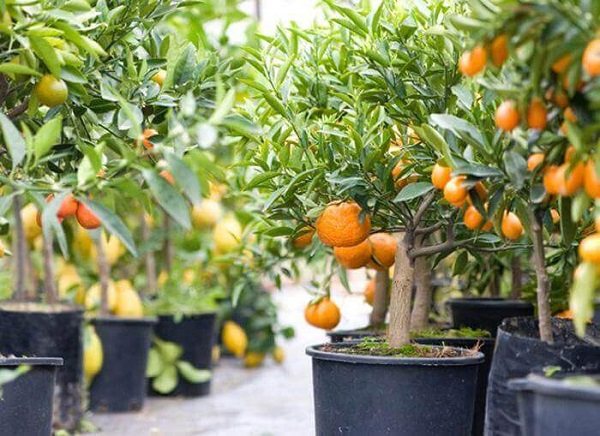

Complete fertilizer
In winter, the tangerine tree does not need to be fed, but from mid-spring to autumn, when buds are formed, it should be fertilized. Meals need to be brought in 2-3 times monthly. For this purpose, it is recommended to purchase complex preparations containing the following substances:
You can find good fertilizers at almost any gardening or botanist store. It is advisable to give preference to the following means:
- Kemir suite;
- Uniflor-bud;
- Uniflor-growth.
Organic fertilizers should be alternated with mineral fertilizers. Homemade remedies are made on the basis of poultry manure and cow dung. To do this, one part of the dried substance must be diluted in ten parts of pure water, after which the composition should be infused for two to four days.
The soil must be thoroughly moistened before fertilizing.If chemicals are used, then it is imperative to follow the requirements of the instructions, since if the dosage is exceeded, the plant can easily be harmed. In this case, mineral preparations should not come into contact with the fruits of the plant.
Planting a mandarin
What seeds to plant?
For planting tangerines, it is best to take seeds from the many hybrids offered for sale today. They sprout faster, bloom earlier, in most cases, produce edible fruits and are easier to graft. It is very simple to distinguish them from real tangerines: the real ones do not have seeds in the fruits, or there are very few of them, and hybrids are always with seeds.
The selected seeds should not be thin, as if dried out, deformed or with a blackened tip. It is good that there are at least five mandarin seeds, since not all will germinate, and if the plants are planned to be grafted, then at least ten, because grafting is not always successful.
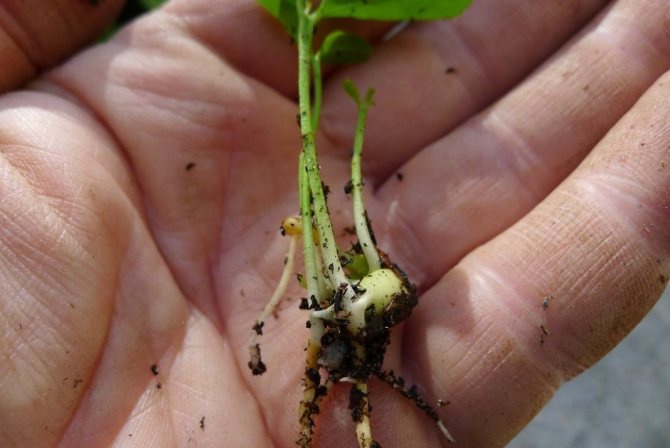

Tangerine sprouted from seeds.
Cooking the ground and picking up the pot
The next task is to prepare the substrate. There should be no peat in it, since mandarin does not like acidic soil. Therefore, the substrate is either bought in a store, marked with a pH = 6.5-7 (neutral soil), or they are made on their own by mixing two parts of well-rotted humus, two parts of forest land (from under deciduous trees) and one part of sifted river sand. If there is no humus, you can just take non-acidic soil and sand.
Now you need to pick up a container for planting. The first pots for young tangerines are quite capable of being plastic cups with a volume of 200 ml, bowls with a depth of at least 7-9 cm (always with a drainage hole) or small pots.
Planting mandarin seeds
For all citrus fruits, there is a single rule: the faster the seed from the fruit gets into the soil, the higher its germination. Therefore, after eating a tangerine, you do not need to dry its bones, you must immediately place them in the ground, digging them to a depth of 4 cm.
If, for some reason, tangerine seeds could not be planted immediately, then, in order to slightly speed up the germination process, it is recommended to soak them for several days. In this case, the dishes in which they will lie should be flat, the cloth should be damp, but not filled with water, the place should be warm, but not in the sun. So that the cloth in which the mandarin seeds are wrapped does not dry out, the saucer can be placed in a plastic bag, slightly covered, but not tied.
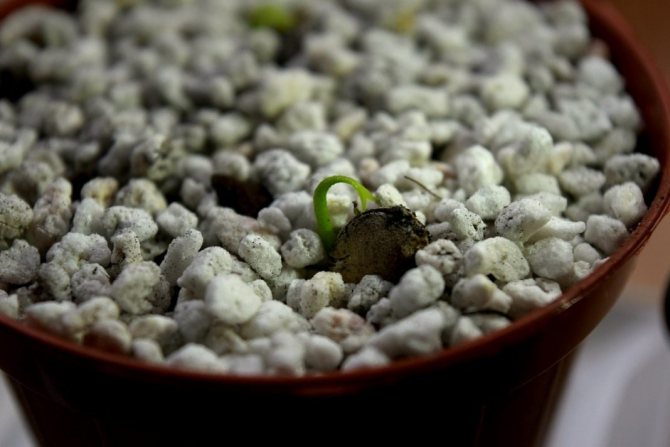

Hatching tangerine from seeds.
From sowing to germination
It is impossible to say in advance how long it will take for the seed to germinate and sprout. In some cases, this is 15 days, but more often - about a month. In any case, before germination, it is important to monitor soil moisture and air temperature, which should not fall below +20 ° C and exceed +25 ° C. At the same time, it is not recommended to place the pots in a mini greenhouse, tangerines sprout so well, and plants grown in greenhouse conditions will then need to be accustomed to the conditions of the room.
Additional recommendations
Before flowering (in spring), the tree is cut off. Eliminate all thin and dried branches, as well as yellow leaves. The pruner must be thoroughly disinfected and sharpened before work. Plant slices - treat with wood resin. This will speed up their healing.
Making an oval crown for a tangerine tree is easy. To do this, you just need to cut off excess shoots and pluck the upper parts of the branches. It is recommended to leave 10-15 buds for the first flowering of the plant. It is better to cut off all the rest, as they will absorb too many nutrients and minerals. As the trees grow older, you can increase the number of ovaries left.
It is also useful to put wood supports in the tub, tying branches with fruits to them.Large fruits pull the plant to the soil, so it can easily break or split.
Citrus must be bathed every month. For this, the pot is covered with polyethylene and taken to the bath. First you need to moisten the sheets, then gently process them with a soft cloth and soapy water, removing cobwebs and accumulated dust. It is recommended to wash off the foam under low pressure. The water temperature should be at room temperature. Then the branches and leaves should be wiped with a dry cloth and the tree should be left in the bathroom to dry completely. Only then can the plastic wrap be removed.
Caring for a tangerine tree is no more difficult than caring for a garden orchid and apple tree. A small amount of water, good lighting and well-chosen fertilizers - and the plant will stretch out, and delicate buds and bright leaves will appear on it. In summer, the plant will delight you with a pleasant smell, and in winter it will surely thank you with healthy and tasty fruits.
Mandarin description
Mandarin (Citrus reticulata) is a tree not exceeding 4 meters in height, or a shrub. Young shoots are dark green. Cases are described when, by the age of 30, the tangerine reached a five-meter height, and the yield from such a tree was 5-7 thousand fruits.
Mandarin leaves are relatively small, ovoid or elliptical, with almost no wings or slightly winged petioles.
Mandarin flowers are single or two in leaf axils, petals are dull white, stamens are mostly with underdeveloped anthers and pollen.
Mandarin fruits are 4-6 cm in diameter and slightly flattened from the base to the top, so that their width is greater than the height. The peel is thin, does not grow tightly to the pulp (in some varieties, the peel is separated from the pulp by an air layer), 10-12 lobules, well separated, the pulp is yellow-orange; the strong aroma of these fruits differs from other citrus fruits, the pulp is usually sweeter than orange.
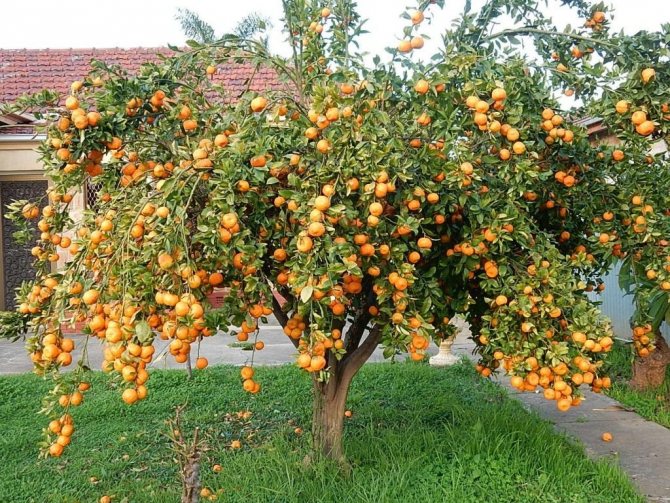

Mandarin tree.
When you need a mandarin transplant
The tangerine tree is transplanted in the spring, when the plant wakes up after winter and all its processes are activated. Since this plant develops very quickly, it is recommended to replant a young tree once a year, while the new pot should be 2-3 cm larger than the previous one. And at the age of seven, when the flower is already considered an adult, a mandarin is transplanted every three years.
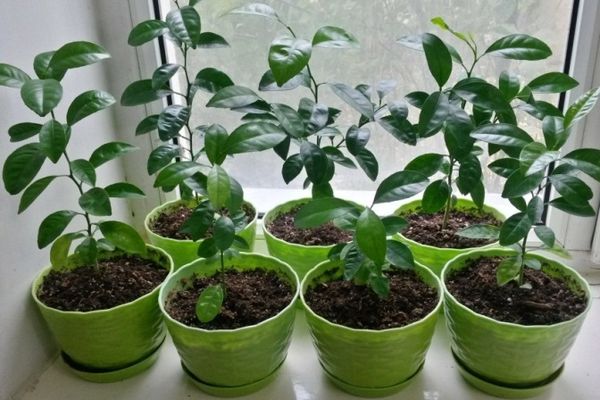

First, make sure that a transplant is necessary, for this, make a small dig and feel the condition of the roots. If the root system is densely enveloped in the soil, then replant, and if the roots are loose, it will be better to change the topsoil and leave the pot the same. Do not forget that there will be no point in transplanting if the plant is blooming at this moment. It is better not to touch the tangerine tree at all in the flowering phase. Therefore, knowing how and when to transplant tangerines at home, you will achieve the most positive results.
How often should a tangerine tree be replanted?
1. Each tree expands its territory by increasing the roots, tangerine is no exception. It needs to be moved from a small pot to a large one. Moreover, this procedure is carried out every year.
2. If we talk about a four-year-old tangerine, it is moved directly into a wooden tub (pot). Further, within 2-3 years, the tree will successfully bear fruit and develop.
3. The most favorable time for the relocation of the mandarin is early spring. At this time, the citrus awakens. Manipulations begin with a small digging, which is done in order to check the condition of the rhizomes.
4. If the root system is tightly entangled around a lump of earth, the tangerine needs a transplant. In other cases, it is enough just to remove the upper part of the soil and cover a new layer. In this state, the tree is left for another year.
Choosing a pot for transplant
There is no reason to worry about choosing a new pot for planting a citrus tree.If your plant is at the most preparatory stage for growing, then a simple plastic cup may generally be suitable for it. But if you want an exquisite pot for the future plant, then any other miniature container up to 10 cm deep will do. But do not forget that the root system grows very quickly, and soon you will need another glass or flowerpot for the correct transplantation of the indoor tree.
Why do mandarin leaves turn yellow?
1. The leaves on the tree begin to turn yellow if the plant was transplanted without following the proper rules. The root collar can be deepened by a sound.
2. Also, a large pot can cause a similar problem. Fix everything, the plant will recover.
3. If the tangerine tree felt fine for a long time and suddenly began to throw off the leaves, do not panic.
4. The dormant plant can shed yellowed leaves. Most often, this process occurs in the off-season. You should also reduce watering.
Required soil and substrate
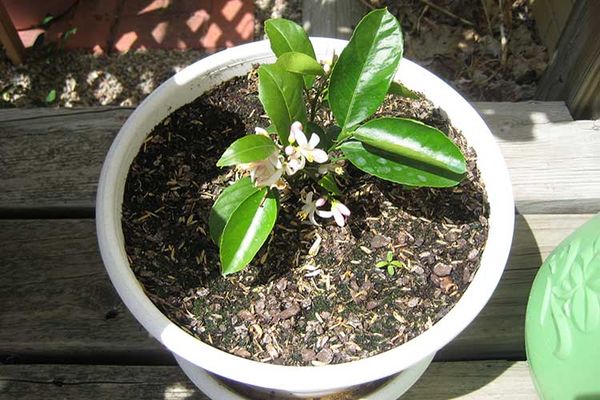

The correct transplanting of a homemade tangerine tree begins with choosing the right substrate. This is one of the main points and it is not worth saving on it. It is better to purchase ready-made soil in a specialized store, pay attention that it is slightly acidic, without other impurities. The earth should be very airy and nutritious, retain moisture well and allow air to pass through. If you do not trust universal soils or you just have a desire to prepare the substrate yourself, then the opportunity to prepare the right mixture always exists. For tangerine trees, the following components are suitable:
- turf and leafy soil in equal proportions;
- coarse river sand, which must be disinfected before use;
- humus;
- clay in very small quantities.
When replanting a plant, do not forget about the need for drainage. At the bottom of the flowerpot, 3-5 centimeters thick, drainage is lined, expanded clay and small pebbles are ideal. The indoor tangerine at the bottom of the large stones, which perfectly let the air through and prevent stagnation of water, will really like it. One little secret: the neck of the indoor tangerine tree, after you transplant it, should remain at the same level above the ground, as in the other pot.
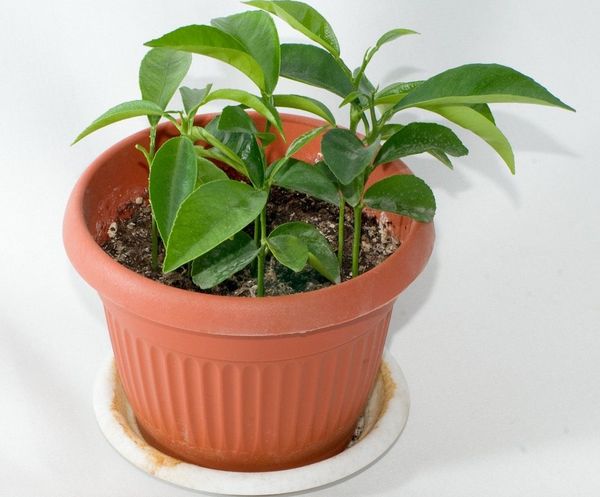

After completing the process, immediately water the soil, it will settle down a little, then add a little more soil and water one last time.
Is it possible to grow a tree from a tangerine seed?
There are several ways to plant a tangerine tree at home:
- using seeds;
- handle;
- layering;
- vaccination.
The seed method of reproduction is the simplest. One has only to take into account that a tangerine tree from a stone will begin to bear fruit no earlier than 5-6 years after planting. The seeds can be purchased from the store or collected by yourself. For this you need:
- Choose large ripe fruits.
- Remove the bones from them, which are then washed under running water.
- Dry the seeds.
- For germination, the seeds are placed in a container with room temperature water, which is placed in a warm place, for example, on a sunny windowsill.
- After the first shoots begin to hatch, the seeds can be planted in the ground.
Rules for caring for a transplanted tree
One of the basic rules is that indoor tangerines need light! And the more it is, the better: the tree is filled with health and energy, and the fruits - with juice. Place it in the house near the windows, and if it is on the south side, then it is still desirable that the glass be covered with blinds or any other diffusing device. It will badly affect the leaves if they are in direct sunlight. In the warm season, you can expose homemade tangerine flowers to the open air: balconies, loggias, orchard, but adhere to the rules of protection from the sun.
In winter, it is a little troublesome with this plant, since daylight hours for it should last at least eight hours. You will have to highlight it with phytolamps, otherwise the tree may get sick, and in rare cases, even die. Therefore, you need to take this item with great responsibility.
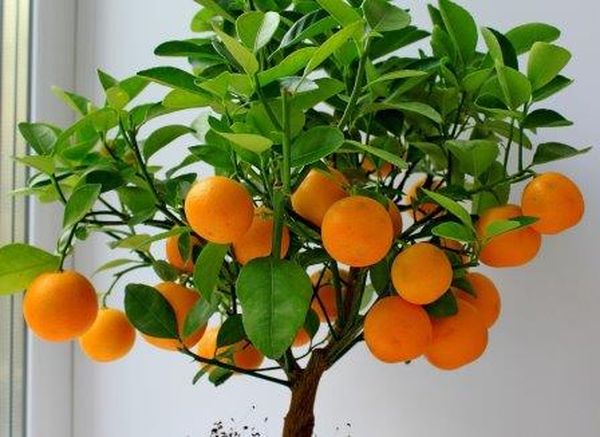

As for the air temperature, the optimal value will be 20-25 degrees, if this figure decreases, then do not wait for the fruits, they will ripen, but inside they will be hollow. In winter, it is recommended to put the plant in a cool room - this is necessary so that it can rest before the important and active phase of flowering in spring. Having gained a lot of strength, indoor citruses give much more fruit, and they are also juicier and sweeter.
The air humidity should be high, so it is worth spraying the flower with clean water three times a day. In a hot period, it will be better to place a bucket or bowl of water near the pot to prevent the air around the tangerine from drying out. In winter, it will generally be ideal to use a humidifier, especially if the flower is located next to heating devices. And do not forget to ventilate the room: fresh air has a beneficial effect on development, but do not allow drafts to appear - the indoor tangerine does not tolerate this, like any other house plant.
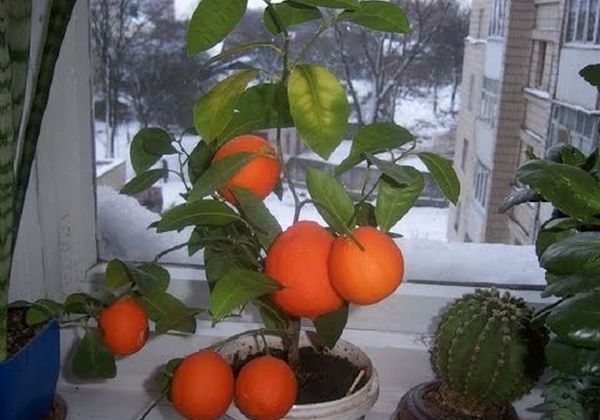

After you have transplanted the tree, be sure to water it, and then monitor the condition of the soil. It should always be wet, but not wet, to prevent rotting. Most often it turns out that in the summer watering is done once a day, and in the winter about 2-3 times a week. Pay attention to the pallet - if water accumulates in it, then reduce the number of waterings.
Use purified and settled water for irrigation, tap water contains a lot of salts and impurities that are retained in the soil and have a bad effect on the appearance of the plant. When watering, try not to get on the trunk and leaves. Morning is considered the most successful time, since the tree, like all living things, wakes up, and the water starts all metabolic processes in the body.
Conditions for keeping a tangerine tree at home
It is important for happy citrus owners to know how to care for a tangerine tree in compliance with all conditions. This is the only way to provide a tangerine in a pot with a long life at home.
# 1. Lighting
1. All citrus fruits love sunlight, so this must be taken care of in advance. Create a spot for the tree. A tub with a young seedling is placed on the northern window sill. Older trees are planted on the east and west side.
2. Mandarin grows well and bears fleshy fruit when placed on the south side. The main thing is that the windows have blinds or tulle to diffuse light.
3. It should be understood that severe UV rays negatively affect the tangerine crown, burning it. Direct sunlight also dries up the soil, so don't keep the tree under the scorching rays.
4. In the summertime, the citrus tree is transferred to the garden or balcony. It is advisable that the tub is located under spreading trees or be covered with something else. Such a move will scatter the light and smooth out the "blow" on the tree.
5. If the plant is installed in an apartment on a window, at the very rush hour (noon) it must be transferred to the shade or curtains. Towards evening (4 pm-6pm) the windows open.
6. In winter, due to the lack of natural light, it is necessary to warm the tree with phytolamps.
7. Since it is necessary to care for a tangerine tree with respect to daylight hours, consider this when growing in a pot at home. Daylight hours last 8-12 hours, no less. Otherwise, the plant weakens, its leaves turn yellow and fall.
Important! Special light bulbs can be bought at the “Everything for Home and Gardening” store.When using them, periodically turn the tree to the light in different directions so that it warms up evenly.
# 2. Temperature
1. The first buds on a citrus tree can be seen in spring. It is very important at this time to maintain the temperature regime so that it does not drop below 21-25 degrees. If the temperature drops to 15-17 degrees, the tree will be covered with fragrant, but not bearing fruit, barren flowers.
2. In the winter season, the mandarin must be moved to a cool room so that the plant is not exposed to strong heating radiators. Reduce the room temperature very slowly, otherwise the tree may lose some of its leaves. First, keep the indicators at +18, then reduce to +16, then +14. Some amateur gardeners even lower the mark to 10 degrees.
Important! Mandarin is prepared for hibernation after picking the fruit. In winter, the citrus tree is kept cool to increase its energy reserves. In such conditions, the tangerine rests, and after waking up, it gives even more buds. Its fruits take on juiciness, sweetness and look very bright.
3. Before caring for a tangerine tree according to all the rules, learn a few more subtleties when growing in a pot. At home, around 10-20 January, you can gradually increase the temperature in the room. The tree should wake up from hibernation and prepare for flowering.
Number 3. Humidity
1. Mandarin loves not only warmth and light, but also moderate humidity. In hot weather, spray the plant 2-4 times a day with standing water from a spray bottle.
2. In summer, take care of normal air humidity, place a container of water next to the pot or purchase a compact humidifier for your apartment.
3. In winter, buy an ionizer and, again, a humidifier. If you have installed a pot with a tree near the heaters, cover the radiator with a wet sheet or towel.
4. Do not forget to ventilate the room in which the citrus pot is installed in a timely manner. However, with such manipulations, it is necessary to remove the tangerine tub to the side, because the citrus will not tolerate drafts and temperature surges.
How to grow a tree from seeds
How to grow a tangerine at home? It is best to buy an already grown seedling, but a more interesting option is to plant it from a bone. The seed for planting should be chosen from a juicy and ripe tangerine, it is better to choose not one seed, but 10-12 pieces. Before planting, the seed must be germinated in a humid environment, such as wet gauze. After the bone swells and sprouts appear on it, you can proceed to planting in the ground. The substrate can be prepared independently or you can buy a ready-made composition. The land for planting citrus should consist of one part of humus, leafy soil, clay and sand. All this is enriched with three parts of sod land and mixed well.
At the bottom of the container, expanded clay or pebbles are laid out as drainage. Sprouted seeds are buried five to seven centimeters into the ground and sprinkled with a substrate. After that, the container with the plant is removed to the windowsill. Do not allow direct sunlight to fall, otherwise the sprouts may simply burn out. After the first shoots appear, you can start feeding the bush with organic compounds and fertilizers for citrus fruits. Most often, feeding is done during the growing season with mixtures containing nitrogen, phosphorus, potassium. When fertilizing, the proportions should be observed, otherwise, you can burn the young shrub. Top dressing is carried out every 14 days.
Some buds must be cut from the tree so that the plant does not deplete during flowering. It is better if only a few flowers remain on the branches, but ovaries will appear from them, which will turn into juicy fruits. Pruning branches and dry foliage should be cut.
Now read:
- Planting to decorate the site with three types of conifers
- Choosing cucumbers for open ground according to your preferences
- Exquisite junkus (sitnik) spiral in the interior
- Zircon for plant growth based on natural ingredients
About
Leading Researcher of the Laboratory of Vegetable and Berry Crops, Yakutsk Research Institute of Agriculture, Siberian Branch of the Russian Academy of Agricultural Sciences, Republic of Sakha (Yakutia).
Propagation by cuttings
When growing indoor tangerine from seeds, you need to wait for the first fruits for a long time. Therefore, it is better to take seedlings from a plant that has already passed adolescence. For cuttings, an annual shoot is chosen (young shoots, but slightly woody), cut it off, and then cut it into pieces so that each one has 2 leaves. The cuttings are placed in a moist substrate and transferred to a place where the temperature is not lower than 25 degrees Celsius. To make it easier for them to root, before planting, it is worth dipping the tips of the shoots in Kornevin. The pot is placed in a plastic bag to create a humid microclimate. There must be holes in it to ensure air exchange.
Seedlings should be placed on a windowsill or in a bright place, but not exposed to direct sunlight. Care must be taken to maintain constant soil moisture. The plant should take root within 5-6 weeks. After this time, it is transplanted into a pot with suitable soil.
Young seedlings grow very quickly, therefore, in the first years of cultivation, this plant requires an annual transplant. Older specimens grow more slowly, so you need to replant less often - only when the container becomes too tight for a room tangerine.
Indoor tangerine - reproduction
How to propagate tangerine seeds, we have described in detail for you. There are other ways of plant propagation - vegetative. Unfortunately, mandarin cuttings are very difficult to root, so here are two other ways to propagate this citrus crop.
Reproduction of mandarin by air rooting
Air rooting allows you to get a new plant in the form of an already large tree, which can bloom next year. Shoot rooting is carried out directly on the mother plant. In the spring, select a three-to-four-year-old branch on the crown with well-developed shoots growing in all directions, make a 1 cm wide annular cut of bark on it 15-20 cm below the last branch and put a pot of soft plastic cut on one side with a drainage hole on the branch exactly the same size as the branch diameter. Sew the cut side with a wire and fill the pot: put moss, small shavings or sawdust on the bottom, then sand, and then wet sod-leaf humus with sand (3: 1). From the moment of swelling on the branch of the buds, 50 ml of a five percent solution of ammonium nitrate should be poured into the pot daily. You will learn that rooting has occurred by the resumption of leaf growth, but do not rush to separate the rooted branch from the tree: wait until the growth of shoots stops on it and the young leaves mature.
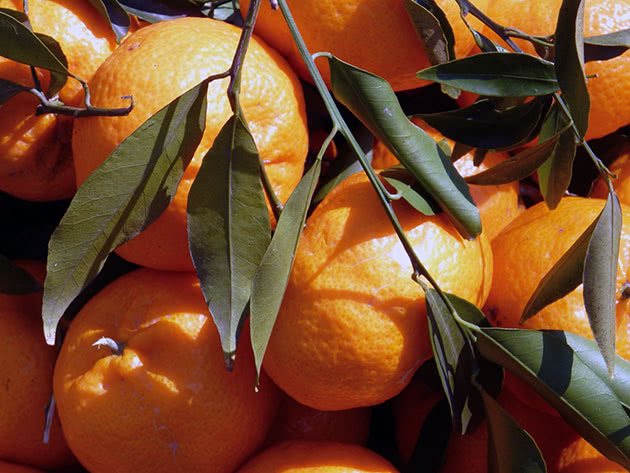

Instead of a pot, you can use a plastic bag filled with a moist substrate of the described composition, which is impregnated with a 1% solution of Heteroauxin. The bag with the substrate is put on the branch at the cut point, and the bag is tied up above and below this place.
After about six months, the branch is separated from the tangerine: it is cut under the bag or under the pot, and when the plastic is removed, there is still part of the shoot that needs to be cut right under the new root system. After that, the sapling tree is planted in a pot with drainage and nutritious soil and for the first time is protected from the sun with white paper. Every day you need to spray the leaves of the seedling with water, and if they suddenly start to fade, put on a large transparent plastic bag on the tree.As soon as the plant regains the turgor of the leaves, the bag is removed from it, but not immediately, but gradually accustoming the tangerine to the conditions of the room.
How to plant a tangerine
The easiest way to inoculate citrus fruits is budding, that is, inserting a scion bud into the bark of the rootstock. Two to three-year-old seedlings of citrus crops with a stem as thick as a pencil or a little more are used as a rootstock, and a varietal mandarin stalk as a scion. Budding is carried out on a cloudy day during the period of sap flow: at this time, the bark, exposing the cambium, is easily separated from the wood. A few days before grafting, the stock is well watered, and the stalk with an eyelet is lowered into a vessel with water, after removing all the leaves from it, but leaving the stalks in the eyes.
Select a smooth place on the rootstock 5-10 cm from the ground without thorns and buds and carefully make a shallow T-shaped incision on it (transverse about 1 cm long, and longitudinal 2-3 cm long), slightly pry the edges of the longitudinal incision and turn it off slightly bark: in this place you have to place the eye of the scion cuttings. Now cut off a peephole from a varietal scion (a bud with a petiole sticking out of it), grabbing with a sharp knife not only the bark, but also a thin layer of wood - the shield. Above the peephole there should be 1 cm of bark, and below - 1.5 cm.Take the cut peephole by the petiole and insert it into the T-shaped cut of the rootstock, as in a pocket, inserting the shield from top to bottom, then bandage the vaccination site from bottom to top with PVC or polyethylene tape.
You can graft two eyes on one stock on different sides of the stem.
- Soil preparation for seedlings
Reproduction methods
The exact breeding option will depend on the variety of mandarin. So, only adult trees with well-developed and formed branches propagate by air layers. Planting seeds is one of the easiest ways, it requires seeds from ripe fruits to propagate the plant, but in this situation, it will take the longest to wait for fruiting. Layers are well-formed tree branches. They are pruned and placed in the water until the roots form.
The most economical way to get a mandarin seedling is to grow it from seed. This approach will take a lot of your time and patience. If the tree already exists, and you want to get offspring from it, then choose one of the following methods:
- Propagation by layering, which is a well-formed tree twigs. Choose a branch from an adult mandarin with a thickness of 4 mm and a long enough to bend the branch and pin it to the ground. You do not need to separate the branch from the bush, just dig it in with earth. In this case, the top will protrude from the soil surface. Keep the digging site wet. When the cutter has new roots, separate the branch from the mother plant.
- Reproduction is carried out by cuttings. For this, the so-called air layers are used - the cutting is rooted "in the air". An adult shoot is cut in a circle, cutting off the bark about 1 cm wide, after which the wound is treated, wrapped with sphagnum moss and polyethylene (loosely). The resulting "pupa" needs to be kept wet until the roots form - it will take several months.
You can get a houseplant in several ways:
- seeds;
- cuttings;
- layering;
- vaccination.
Seed cultivation is used in the absence of its own specimens at home. Propagation by layering is suitable for old trees. Cutting is used only for some varieties of indoor mandarin in order to obtain a varietal fruiting plant. The grafting is suitable for those who already have a sprouted tangerine sprout and any other citrus that can be grafted onto.
Budding
If you have a single-bud stalk, budding can be done. First, wipe the barrel with a damp sponge. It is necessary to process an area at a height of 10 cm.A bud with a small piece of wood is separated from the cuttings. An incision is made in the bark in the form of the letter "T". It should be 2.5 cm high and 1 cm wide. It should be carefully expanded. A kidney is inserted here. It is covered with bark.
The incision site is wrapped with tape, treated with an antiseptic. The kidney remains free. The tree is left in the greenhouse. The kidney is covered with a plastic bottle. You can use plastic wrap. It is necessary to ventilate the greenhouse so that moisture does not stagnate inside. When the stalk takes root, starts up the first shoots, the trunk must be cut off by a third at a distance of 7 cm from the scion.
Reproduction
Mandarin is propagated by seeds, layering. Adult specimens that are well formed are propagated by air layers. You can try propagation by cuttings by placing them in water.


To achieve a harvest, trees are grafted. This is done in the spring, in May-April. You will need the following:
- The stock is the tree itself to be grafted onto.
- A graft is a sprout from a healthy, fruiting plant.
At a height of about 7 cm, a sharp T-shaped incision is made, which it is advisable to disinfect. The bark is slightly pushed back, and the resulting incision is placed in the scion. After that, this place must be treated with garden varnish.
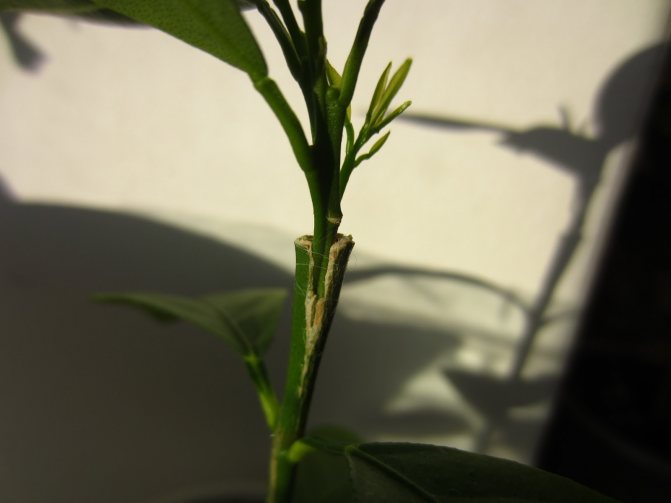

Some gardeners prefer to simply tie it with a thick cloth. Next, the plant is placed in a greenhouse or a plastic bag is put on it. It will take about a month to germinate.
Truths and myths about tangerines
Information about citrus fruits appears constantly, but it is not always worth believing in it. Let's dwell on false and true statements.
Invalid data
- tangerines are best absorbed in the morning;
- tangerines are useful only in the evening;
- the presence of a large amount of organic acids in citrus can provoke gastritis and negatively affect the gastrointestinal tract;
- the presence of a large amount of sugar in fruits can lead to a sharp increase in weight in a person when they are consumed at night;
- you can eat tangerines in unlimited quantities;
- it is worth reducing the use of tangerines to 4 pieces per day;
- there is more vitamin C in tangerine than in orange.
True truth
- tangerines help to improve metabolism;
- the presence of synephrine in the peel and pulp helps to accelerate the metabolism in the body, which leads to the destruction of adipose tissue;
- citrus juice is able to kill germs;
- mandarin has bactericidal properties due to the presence of phytoncides in it;
- citrus fruits are used for dysbiosis;
- due to the presence of organic acids in the composition of mandarin, the intestinal microflora improves.
Diseases, problems in growing
A tangerine tree gets sick if the rules for caring for it are not followed.
Yellow leaves:
- Bay.
- Lack of nutrients.
- Oversupply of fertilizers.
- The appearance of pests: spider mites, aphids.
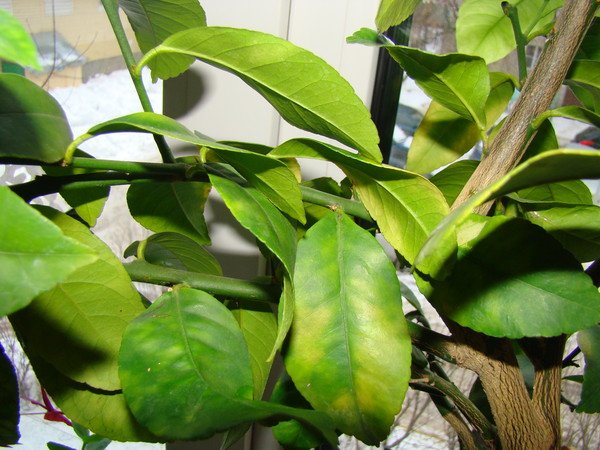

Shedding foliage:
- Excessive drought.
- Draft.
- Bay.
- Permutation.
- Transplant errors.
- Lack of lighting for a long time.
- Dormant period - sometimes in winter the plant can remove some of the leaves.
It is important to monitor the humidity of the air. Mandarin won't like being around central heating radiators.
Sometimes pests can attack the plant:
- Spider mite.
- Aphid.
- Mealybug.
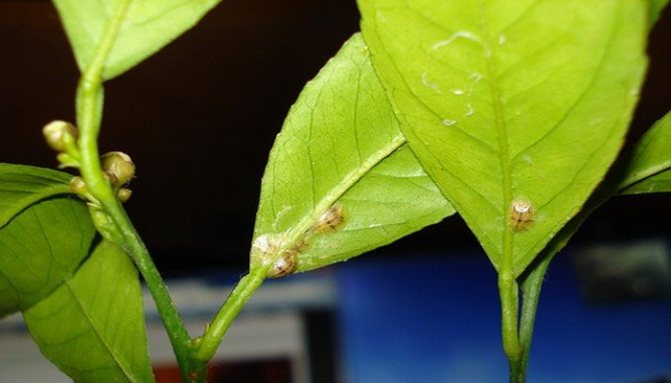

First aid is to wash the plant with a warm shower using laundry soap. It can hold back
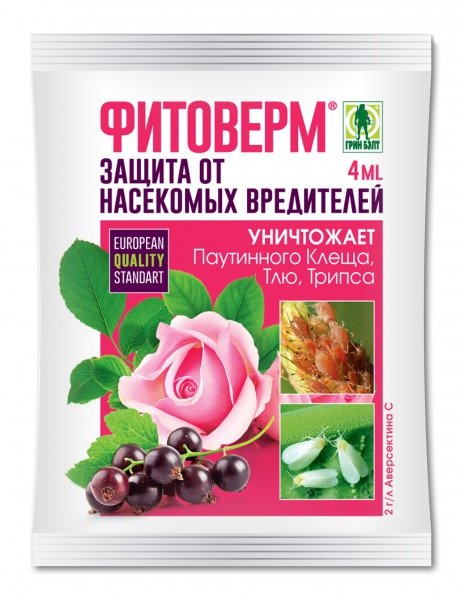

reproduction of pests, but will not completely destroy them, therefore, special preparations are used.
From aphids, worms - Aktar. From spider mites - Fitoverm. Actellic is an effective and powerful agent, but it is not recommended for indoor use.
If you see small jumping insects on the surface of the soil, these are puffs that appear when the soil is waterlogged. The first steps are to dry the soil, perhaps this measure will get rid of them completely.Additionally, drugs Grom 2, Aktara can help. Also, when pouring and using home remedies for fertilizing, mushroom mosquitoes - sciarids may appear above the pot. For them, the same drugs are used as for sugars.
In general, the tangerine case is quite easy to care for and is a good addition to the interior. In addition, it has a beneficial effect on the climate, freshens the air and releases aromatic substances.
The main popular plant varieties
Forged by Vasya
This is a dwarf mini tree that was imported from Japan. The bush does not stretch more than 50 centimeters and has a dense, but not spreading crown. It has no thorns. The tangerine plant should not be pruned and shaped further. Tangerines are easy to peel thanks to their thin skin. Forged Vasya easily tolerates the cold.
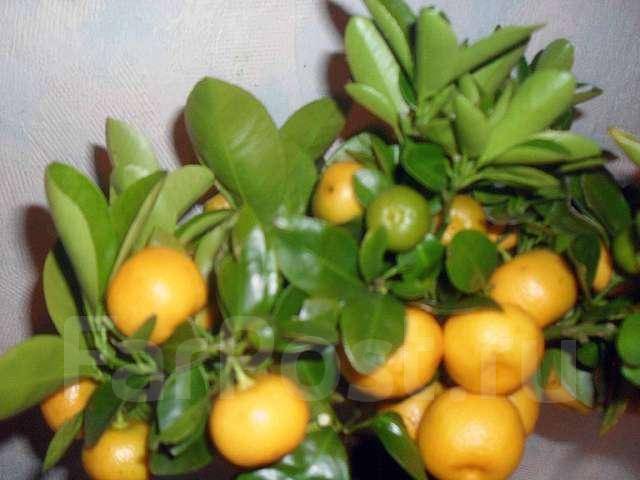

Abkhazian mandarin
It is an early type of indoor plant. The plant begins to bloom in May, and the fruits ripen by October. The Abkhazian variety does not like excess moisture. The fruits have a lot of seeds and a pleasant pulp.
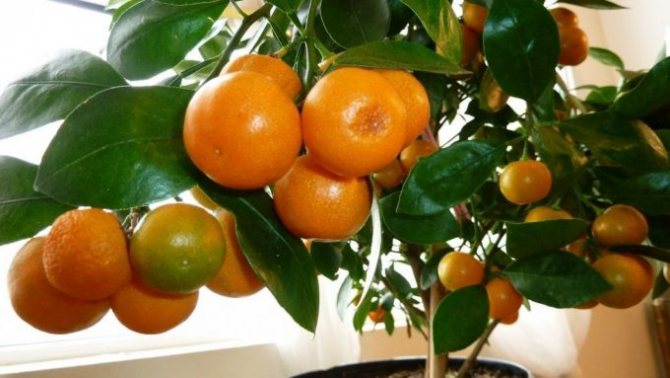

Unshiu
It is a plant that ripens quickly and yields a harvest. During flowering, white flowers form inflorescences. Ripe tangerines weigh up to 100 grams. Plus the variety: the fruits can ripen, even with a small amount of heat and light.
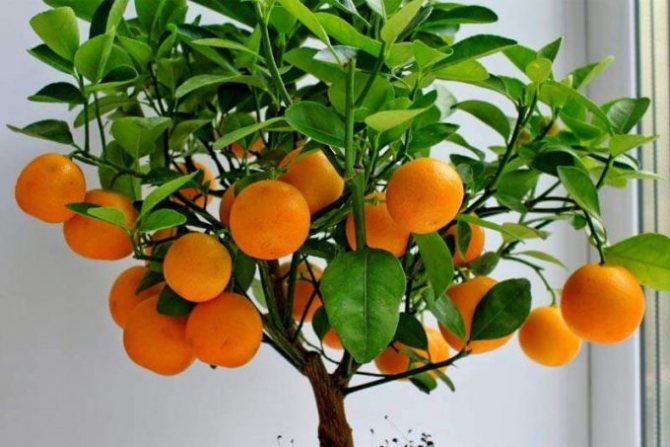

Murcott
It is an American variety. Tangerines on the branches grow in groups. The fruits have an orange rind. There are many seeds in the pulp of the fruit. Tangerines ripen from December to February. It is an indoor variety that is not grown outdoors. In our country, Murcott is rarely common.
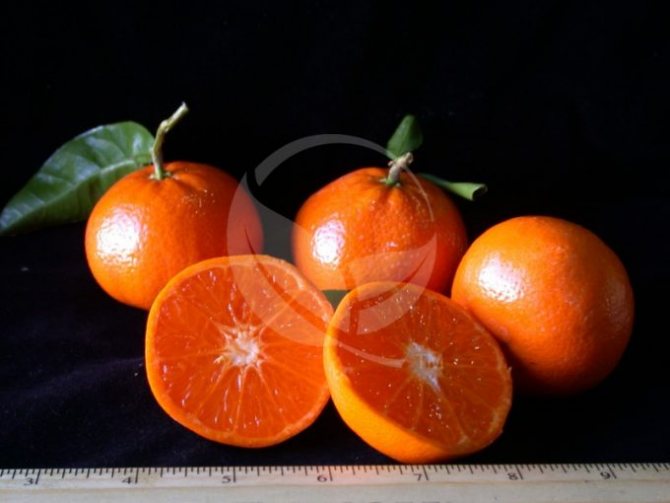

Shiva Mikan
They are actively breeding. He is not afraid of frost and is bred for decorative purposes. It is a dwarf plant with abundant flowering. The fruits ripen quickly, but do not grow large. The maximum mandarin weight reaches 30 grams.
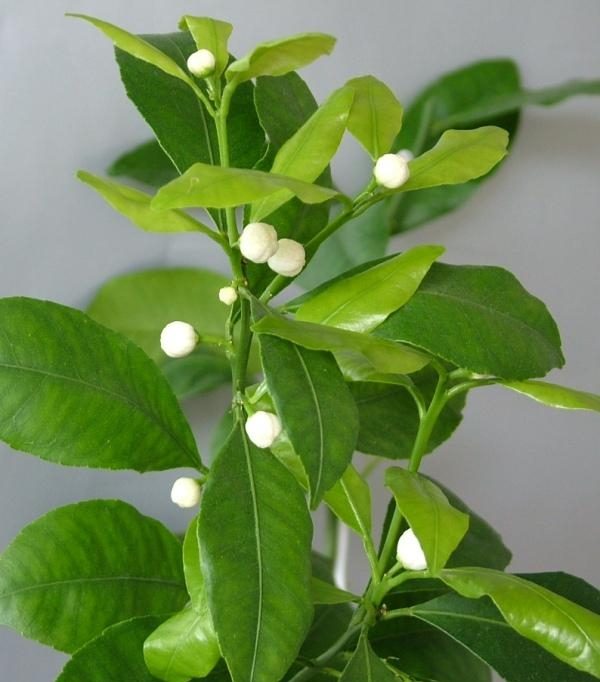

Rubino
It is an Italian variety of the tangerine tree that ripens late. Its fruits are red in color and the flesh of the same shade. Ripe fruits ripen in winter and hang on the branches until summer. At the same time, they do not deteriorate and its taste does not change.
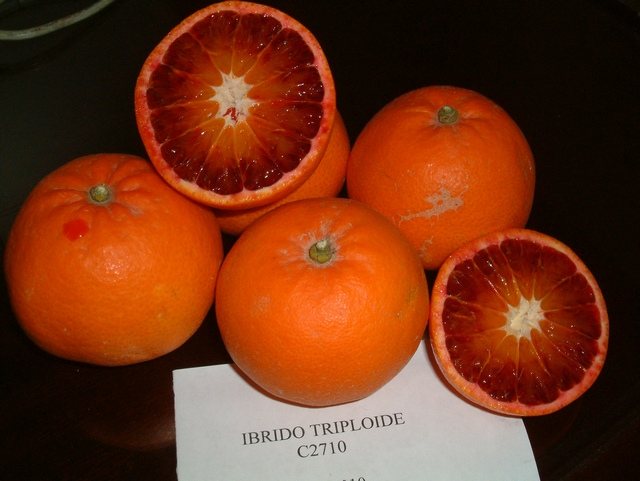

Top dressing of a tangerine tree
With intensive plant growth (March - September), it is advisable to apply fertilizers twice a week. Sometimes just once is enough, but it is not worth frequenting. As for dry fertilizers, you should be even more careful with them. They are more saturated and gradually release all their trace elements to the soil. The land fed by them in the spring does not need additional fertilizers for a long time. The plant quickly uses dry fertilizers and it is difficult to determine how depleted the soil in the pot is. Nevertheless, in no case should the plant be "overfeeded", otherwise an overdose may occur.
With the onset of warm spring days, after the plant has completely woken up, the amount of dressings increases. In early spring, vegetative processes begin, the buds swell, so it becomes necessary to additionally feed with nutrients. Top dressing is carried out until the middle of the day, like all other indoor plants. The room temperature should be between +17 and +19 degrees. Soluble fertilizers are preferred. They are used for watering trees, leaves are sprayed with a weak solution.
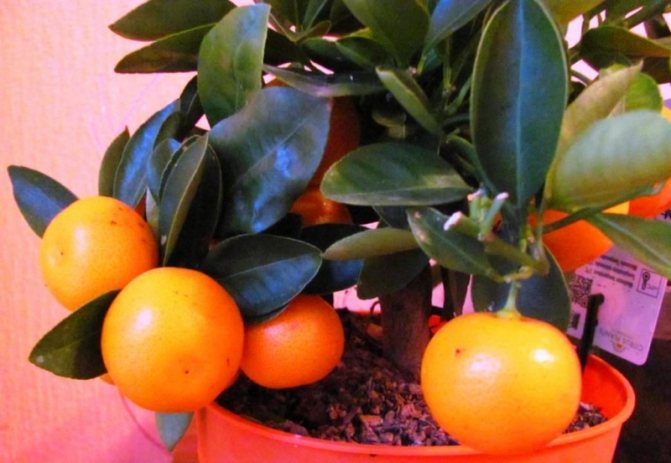

In fertilizing citrus, a variety of complex fertilizers are used, rich in potassium, nitrogen and phosphorus - the main components necessary for the normal development of the plant. Fertilizers are mixed with settled clean water at room temperature. The main condition is not to overdo it. According to the instructions, there is 1 cap of the product for 1 liter of water. The introduction of an excessive amount of fertilizers can negatively affect the development of tangerine: a chemical burn or toxic poisoning of the tree is possible.
Mandarin will grow and develop fully only if mineral fertilizers and organic matter are added to the soil mixture. The soil in the container loses its useful properties over time, is depleted by constant irrigation, and the restoration of the quality of the soil does not occur, unlike the earth in natural conditions. The tangerine tree is fed with dry and soluble fertilizers. Mandarin prefers to feed on organic fertilizers. Infused cow dung is taken and diluted in clean water in a ratio of 1:10. For soil top dressing, the best option is to use both organic matter and mineral fertilizers.
Videos about growing and caring for tangerines:
We treat diseases, drive away pests
The best prevention of any disease and pest attacks is competent agricultural technology. It is also recommended to regularly examine the plant for the appearance of characteristic symptoms.
Table: pests and diseases attacking tangerines
| Pest | Symptoms of defeat | Drugs used |
| Spider mite | Small translucent dots on the inside of the leaves, a thin "cobweb" surrounding the plant | Neoron, Omite, Apollo, Agravertin (according to the instructions) |
| Shield | Grayish-brown "plaques" on the plant, yellow-red tissues around them, sticky transparent plaque | Fufanon, Aktara, Karbofos |
| Mealybug | White cotton-like plaque in the form of small lumps | Inta-Vir, Decis, Tanrek |
| Aphid | Massively clinging tops of shoots, buds and ovaries small greenish-yellow or black-brown insects | Any broad spectrum insecticide |
| Anthracnose | Greenish-white, gradually blackening and expanding spots on leaves and fruits | Any fungicides |
| Root rot | Blackened roots, "wet" spots at the base of the trunk, an unpleasant putrid smell from the soil, yellowing and falling leaves | The manifestation of symptoms on the aerial part of the plant indicates that the process has gone too far. The tree can only be destroyed |
Photo gallery: visible signs of damage to the mandarin tree by infections and parasites
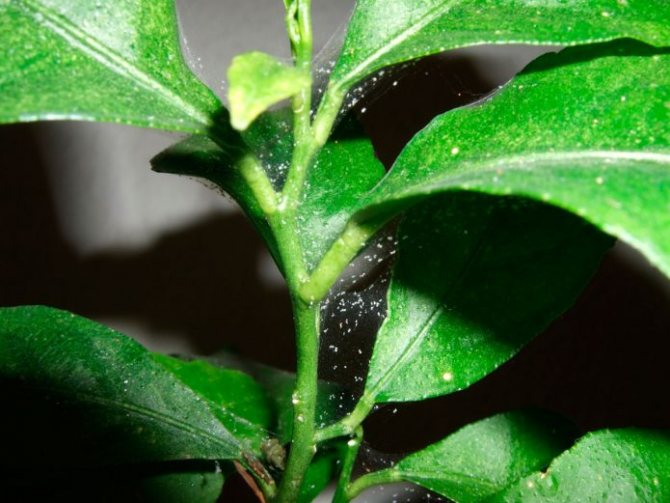

The spider mite is not an insect, so insecticides are useless in the fight against it.
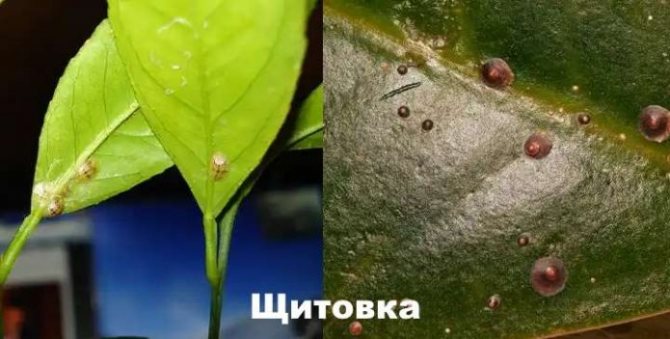

The strong shell of the scabbard reliably protects it from folk remedies - it is better to immediately use insecticides
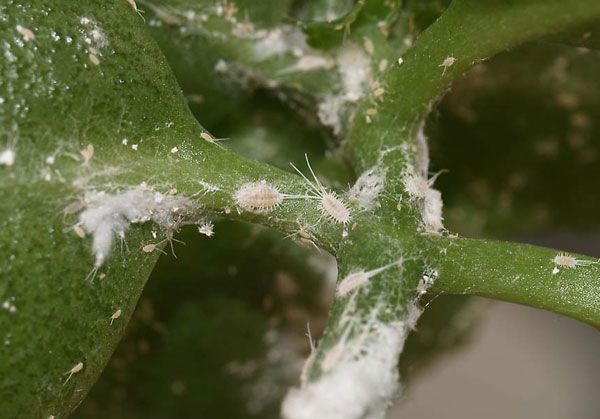

In especially advanced cases, a plant affected by a mealybug seems to be covered with a layer of "wiggling cotton wool"
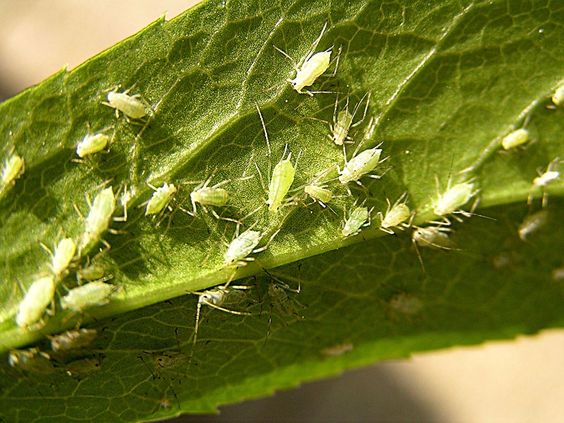

Aphids are one of the most common pests of indoor plants, she also does not bypass the tangerine
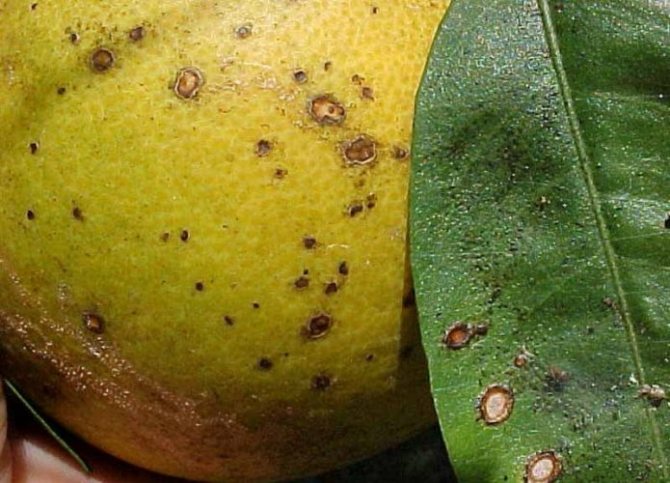

To combat anthracnose, if less than a month is left before harvest, only fungicides of biological origin are used.
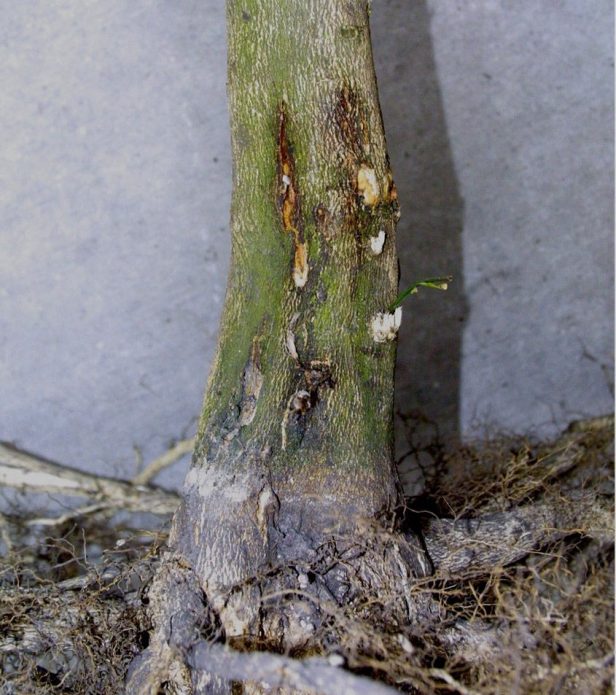

It is impossible to notice in time and, as a result, to take measures to treat root rot - the disease first affects the underground part of the plant
Worms in tangerines are a kind of "urban legend". Nobody saw them, but everyone knows someone who has definitely seen them. In general, this is unlikely, because the increased acidity is not to the liking of worms. But if you do come across a wormy specimen, you shouldn't eat it. The larvae of fruit and berry pests do not pose a danger to humans, which cannot be said about maggot flies.
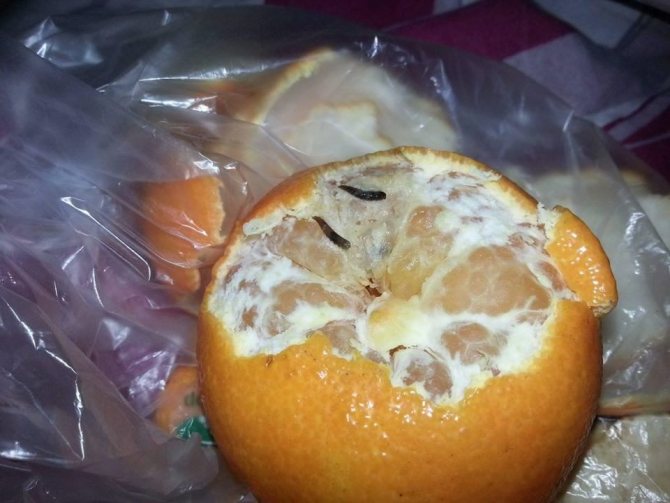

Worms in tangerines are extremely rare, but still possible
Video: common citrus diseases and pests
Correct watering and spraying
It is worth spraying the leaves regularly. Severe dryness of the air negatively affects the development of the tree and serves as a prerequisite for the appearance of spider mites. In the process of flowering, it is necessary to spray in such a way that water droplets do not fall on the flowers. The greater the number of leaves on the plant, the stronger the evaporation occurs and the more often the tree is watered. More evaporation is obtained at high room temperature. Watering tangerine is worth until mid-day. At this time, the life processes of the tree are activated.At room temperature +12 - +15 degrees, watering should be reduced or stopped altogether. The amount of water should be minimal, just to support the plant's vital activity. Dry periods are easily tolerated by the plant. An extreme case is leaf dumping to reduce evaporation. However, too frequent and abundant watering of homemade tangerine leads to the formation of fungal diseases.
Recommendations of specialists. Never water with tap water. For watering, use settled, rain, thawed or spring water at room temperature.
For proper watering, the following criteria must be considered:
- dimensions of the tree;
- the volume of the flower pot;
- room temperature;
- season.
Mandarin leaves should be sprayed daily with clean water with a temperature of +20 degrees.
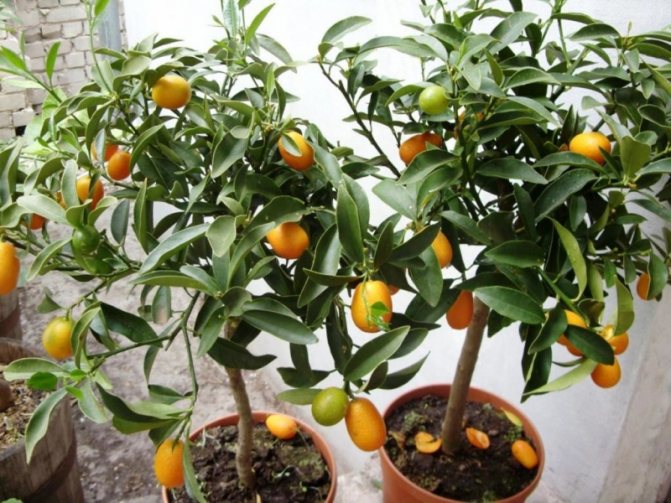

Content
- Description
- Growing a tangerine from a bone How to grow
- Growing in an apartment
- Why does it turn yellow
- Reproduction by air rooting
- Beneficial features
Planting and breeding
Citrus fruit is propagated by seeds or seedlings. In the first case, varietal properties are not preserved, so the tree is recommended to be grafted. After planting the seed, you have to wait 3-4 years. But this method allows you to save money. The price of tangerine seedlings is from 100 rubles. and higher.
An alternative breeding option is layering. It does not require material costs and helps to maintain the quality of the variety.
Growing from a bone
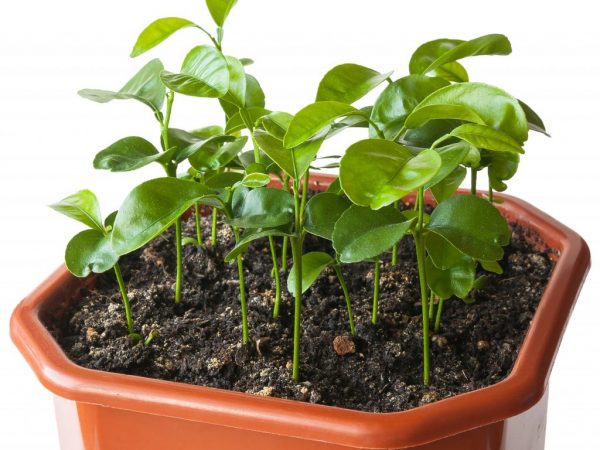

Growing tangerines is not difficult
It is not difficult to grow a tangerine from a bone. The fruits are easy to buy in any supermarket in winter. This is done in December while the citrus fruits are still fresh. The bones are removed from the pulp, washed, put on a saucer and covered with a wet rag. They are placed in a warm place so that the seeds germinate. The rag is constantly moistened. Sometimes a special hydrogel is taken instead of a fabric; it does not need to be watered.
Then the soil is prepared. They buy it in stores (special composition for citrus fruits) or do it yourself. The following soil composition is suitable:
- sheet land - 1 part;
- sod land - 2 parts;
- river sand - 1 part;
- humus - 1 part.
Indoor tangerine does not tolerate acidic soil, therefore peat cannot be added to the mixture. The soil is poured into a pot or container with a volume of 4 liters. Drainage from expanded clay or coarse sand is placed on the bottom. The grain is deepened into the ground by 3-4 cm, the ground is watered. Place in a warm place with a temperature of 20 ° C-22 ° C.
The plant emerges in 2-3 weeks. For reliability, 4-5 seeds are planted in one container, then they are transferred to other pots or pots. The harvest will have to wait a long time, 3-4 years, the bushes are transplanted annually.
Growing from seedlings
Growing cuttings of indoor tangerines is also simple. They buy material in a specialized store or order online. Before buying, they carefully examine the bushes: they should not be stained, moldy. It is advisable to purchase a seedling with leaves and a clod of earth at the roots: it germinates more successfully. If there is an old bush at home, cuttings are cut and placed in water for rooting. After 3-4 weeks, the seedlings are ready for transplanting. The optimal volume of a pot to propagate a tree is 4-5 liters. After planting, the crop is harvested quickly, after 1-2 years.
The tangerine tree is also bought home already grown. This option is suitable for those who have no experience in planting plants. After acquiring a bush in a tub, it remains only to properly care for it: water, spray, fertilize.
Growing from cuttings
Propagation by layers of tangerine is a simple and effective way to root a cutting.Choose a one-year-old twig, about 20 cm long and 4-6 mm thick. With a sharp knife, make 2 circular cuts in the bark, remove it with a ring to force the roots to grow. At a distance of 5 cm above and below the cut, remove all the leaves, pinch the top.
After that, cut a small plastic container in half: take a bottle or an old pot. A twig is placed in it so that the place with the bark removed is in the center. A layer of sand or expanded clay is poured at the bottom, and a nutritious soil (a ready-made mixture or the same composition as for planting seeds) is poured on top.
After 3-4 weeks, the branch gives roots. All this time it is watered, mineral fertilizers are applied twice. When the branch takes root, it remains only to carefully transplant it into a flowerpot with a diameter of 15-20 cm. Reproduction by a shoot is simple, even beginners can do it.
Preparing the soil for replanting mandarin
In search of an answer to the question of how to care for a tangerine tree, it is recommended that you explore options for land suitable for growing a seedling in a pot. At home, you need to do everything right.
So, citrus fruits do not tolerate the acidic environment that accumulates peat. For a tree, you need to choose a soft and nutritious soil so that it retains moisture, but at the same time has good air circulation.
To prepare the soil for the cultivation of young tangerine trees, a mixture is prepared from the following components:
- humus from cow dung;
- sod and leaf types of soil mixed in the same ratio;
- disinfected river sand (coarse).
If you wish, you can not take humus, replace it with compost.
When the tangerine tree reaches the age of 3-4 years, fatty clay is added to the base of the soil. It will prevent drying out of the tree rhizomes and retain moisture for a long time.
It is imperative to lay a drainage layer about 4-6 cm thick in a pot or tub into which the plant will be transplanted. Clay shards, expanded clay or small pebbles are perfect.
Mandarin properties - harm and benefit
Useful properties of mandarin
What is the use of mandarin? Mandarin fruits, rich in vitamins A, D, K, B4, thiamine, riboflavin, rutin, glycosides, phytoncides and essential oils, have a positive effect on the quality of the skin, the functioning of the digestive organs and the nervous system. The fruit pulp contains all types of sugars, ascorbic and citric acids.
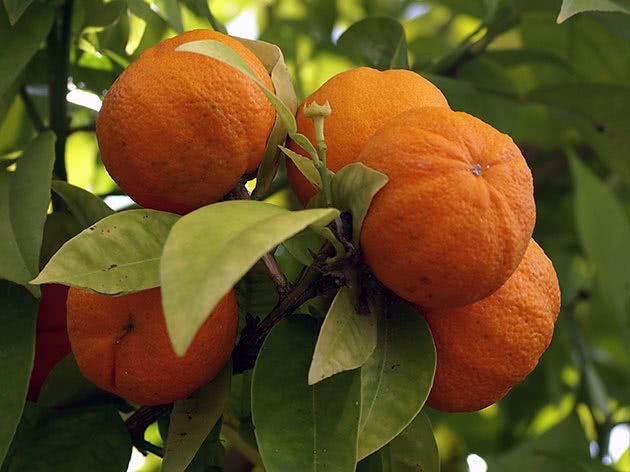

The harm and benefits of tangerine have long been studied, and, giving the plant its due, its fruits are called "flawless citruses." Scientists believe that the pulp and juice of the mandarin fruit:
- increase the tone of the body, therefore, it is indicated even for children with high fever;
- quench thirst;
- have an expectorant and antimicrobial effect, therefore they are used in the treatment of asthma and bronchitis;
- stimulate metabolism and increase appetite;
- have antifungal properties;
- effective in the treatment of dysentery;
- help to increase the elasticity of the capillary walls.
The tangerine peel also has beneficial properties: the tangerine oil contained in it is used to eliminate stretch marks on the thighs and abdomen, correct wrinkles, and relieve skin inflammation.
Description
Indoor tangerine is an evergreen plant from the Citrus genus. In nature, its analogue reaches an impressive height, up to five meters: indoors, of course, tangerines are not allowed to grow to such an extent. In a closed space, it can be grown in living quarters, greenhouses, greenhouses, on insulated balconies and loggias.
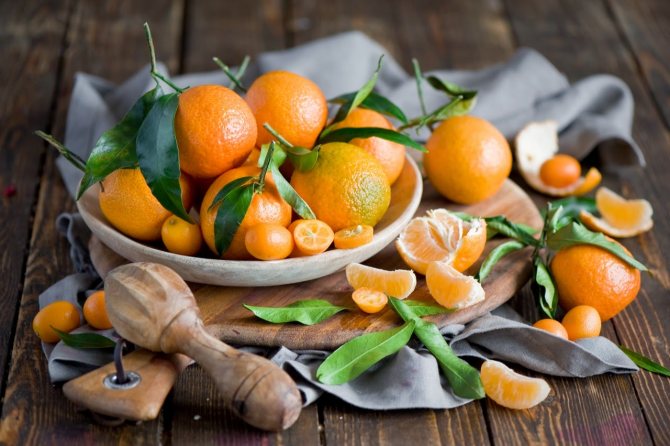

Ornamental mandarin is a very spectacular and vibrant plant. It not only looks beautiful, but also smells great. The foliage is beautiful, dense, has a magnificent, rich shade.
The cultivation of indoor tangerine is accompanied by magnificent flowering: the plant pleases with white, fragrant, small buds collected in a brush. There are species that are capable of blooming for a long time, sometimes all year round.During this period, tangerine smells especially pleasant and bewitching.
It also ripens the fruits - real little tangerines: against the background of rich green foliage, they look like miniature Chinese lanterns. Fruiting occurs with good care: small, neat, spherical flattened orange or red fruits appear on the plant.
They usually ripen at the end of the year, and there is no need to bother with artificial pollination. You can purchase a ready-made plant with already ripe fruits. It is not worth eating these bright tangerines, since in room conditions a lot of fertilizers are required for their ripening.
Mandarin pests and diseases
Mandarin turns yellow
Many amateur flower growers are faced with the fact that the leaves of a tangerine suddenly begin to turn yellow. What is the reason for this phenomenon? There are several reasons. For example, from a lack of nitrogen in the soil, first the lower leaves of the mandarin are covered with yellowness, and then all the foliage gradually turns yellow. This process can be stopped by adding ammonium sulfate, ammonium nitrate or organic matter to the soil.
Against the background of iron deficiency in the soil, chlorosis develops in mandarin: first, young leaves acquire a light yellow color, then more adult foliage also becomes discolored. To prevent chlorosis, mandarin is treated with iron chelate once a month.
Spider mites, tiny arachnids that pierce the leaves of a plant and feed on its cell sap, are another likely cause of yellowing of mandarin leaves. You can see the tick only under a magnifying glass, but sometimes its presence is betrayed by the thinnest cobweb appearing on the plant. To destroy pests, wash the tree under the shower, then treat its leaves with soapy water: put the grated laundry soap in warm water, beat the thick foam and use a cotton swab to wipe the tangerine leaves with foam. To completely defeat the tick, you may need three such procedures with an interval of 2-3 days. The place where the tangerine infected with ticks stood must be thoroughly washed.
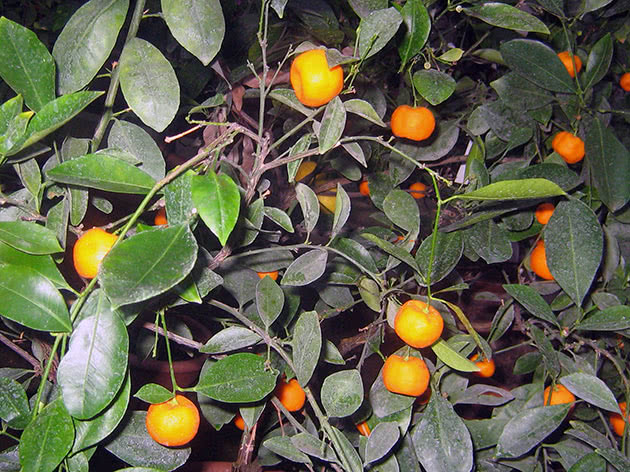

Mandarin leaves turn yellow also from insufficient illumination, as well as from the fact that the pot has become cramped for the plant.
Tangerine falls
Leaves falling from tangerine are not always a sign of any disease. If this happens from late October to mid-February, move the plant to a room with a temperature of 14-17 ºC and reduce watering: the tangerine needs rest. Leaves may also fall off due to low air humidity. In this case, the plant should be sprayed in the evenings with settled water at room temperature and placed around it containers with water. Mandarin leaves fall also due to improper planting: the plant has a too large pot or the root collar is buried in the soil. The reason for the leaves falling off can be a lack of potassium in the soil, drafts, too wet soil in the pot and poor lighting.
Tangerine dries
If, before the tangerine leaves begin to crumble, a dry brown crust forms on their edges, we can conclude that the irrigation regime is violated: you have chronically waterlogged the soil in the pot. To restore normal development of the plant, transplant it into another pot with a good drainage layer and a fresh, leafy substrate. When transplanting, carefully examine the mandarin root system and remove rotten roots. Leaves dry out even in case of insufficient watering. A dying plant will have to be reanimated by placing it in a basin of room temperature water. The water in the basin should reach the edge of the pot. Now you need to water the tangerine until the soil is completely wet and air stops coming out of it. After the procedure, drain off excess water and spray the tangerine with a solution of 1 ml of Epin in 2 liters of water. These sprays need to be continued for some time, 2 times a week.In this way, even a very dry plant is reanimated.
Mandarin pests
In addition to spider mites, mealybugs, scale insects and aphids also damage mandarin. You need to fight these sucking insects with the same remedy as with ticks - soapy water, after having thoroughly washed the plant in the shower. Be sure to protect the potting soil and trunk from soap before foaming the tangerine leaves.
Grafting a tree
Indoor tangerine can grow and develop for a long time at home without fruiting. To speed up the process of forming fruit ovaries, gardeners carry out the grafting procedure.
Before grafting, abundant watering of the tree is carried out to speed up the process of sap flow in the shoots. This will help the bark move away from the trunk better. A well-ripened shoot with several vegetative buds is used for inoculation. All foliage is removed to prevent the process of moisture evaporation and drying out of the branch. The optimum grafting height on a tree is 7-10 cm from the soil level. The bark in this area should be healthy, smooth, without buds and foliage.
A T-shaped incision is made in this area with a sharp knife. The bark in the places of the incisions is raised and a prepared cutting or a kidney with a heel is introduced into it so that the kidney remains on the surface. The raised bark on the rootstock is pressed tightly and wrapped with insulating tape. After the kidney has taken root, the tape is removed.
After successful budding, after about 3-4 weeks, it is necessary to trim the apical shoots on the rootstock, and also remove the insulating tape. Shoot pruning is carried out in two stages - first, the branch is shortened 10 cm above the peephole, then after its germination - at the distance of the thorn upward from it.
In the future, after vaccination for mandarin, home care is the same as for adult specimens.
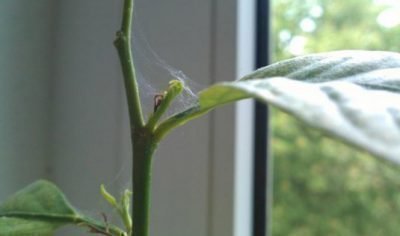

Spider mite on tangerine
Problems
Most often, when growing at home, tangerine is affected by harmful insects: scabbard, spider mite, worm. They fight pests as follows.
Shield
This insect, resistant to insecticides, is eliminated by spraying with a solution of liquid soap - 2 tbsp. spoons of soap or dish detergent in a 3-liter can of water. It is recommended to collect the visible insects by hand beforehand. The remedy is kept on the tangerine foliage for half an hour, then washed off with water.
Mite
If the pest is visible on the leaves, it is harvested by hand. Then they wipe the stems and foliage from all sides with a cotton swab dipped in industrial or medical alcohol. After that, it is advisable to spray with tincture of garlic, onions (200 grams of chopped vegetable is infused in a liter of heated water).
Scratch
Rubbing the foliage with an alcohol cotton swab, followed by spraying with garlic or onion tincture, will also help from the pest.
Tip: it is better to spray in two stages, as one may not be enough. Maintain a weekly or ten-day interval.
If the defeat is strong, and folk remedies clearly do not cope, you will have to use chemical insecticides. In this case, the tangerine in a pot will have to be taken away for a while from the living quarters and while processing is underway, keep it away from people and pets.
Spots on the leaves
The problem usually arises from the tangerine being watered incorrectly. Excessive watering is harmful to the plant: first spots appear, then the foliage begins to fall off and root decay is a critical point in the process. It is not worth bringing to the last, it is necessary to establish watering already at the stage of spots. Otherwise, the death of the plant is likely.
Diseases
The danger is represented by fungal and viral pathologies. As a preventive measure, agricultural techniques are followed, and if the disease has already hit the flower, fungicides are used, or the tangerine is transplanted into another pot with fresh soil.
We found out what kind of care is needed for indoor tangerine. This plant is able to decorate any apartment due to its bright foliage and orange, beautiful fruits. In cultivation, tangerine is simple: by following the available care measures, you can achieve its active growth, lush, long flowering and abundant fruiting.

